Agile Methodology
VerifiedAdded on 2023/04/12
|24
|4465
|310
AI Summary
Agile methodology refers to the process of continuous iterations in software development. This article explores various agile practices such as Scrum and KanBan, along with their benefits. It also discusses other agile methodologies like eXtreme Programming, Crystal methodology, DSDM, and Lean Software Development.
Contribute Materials
Your contribution can guide someone’s learning journey. Share your
documents today.

Running head: AGILE METHODOLOGY
Agile Methodology
[Name of the Student]
[Name of the University]
[Author note]
Agile Methodology
[Name of the Student]
[Name of the University]
[Author note]
Secure Best Marks with AI Grader
Need help grading? Try our AI Grader for instant feedback on your assignments.
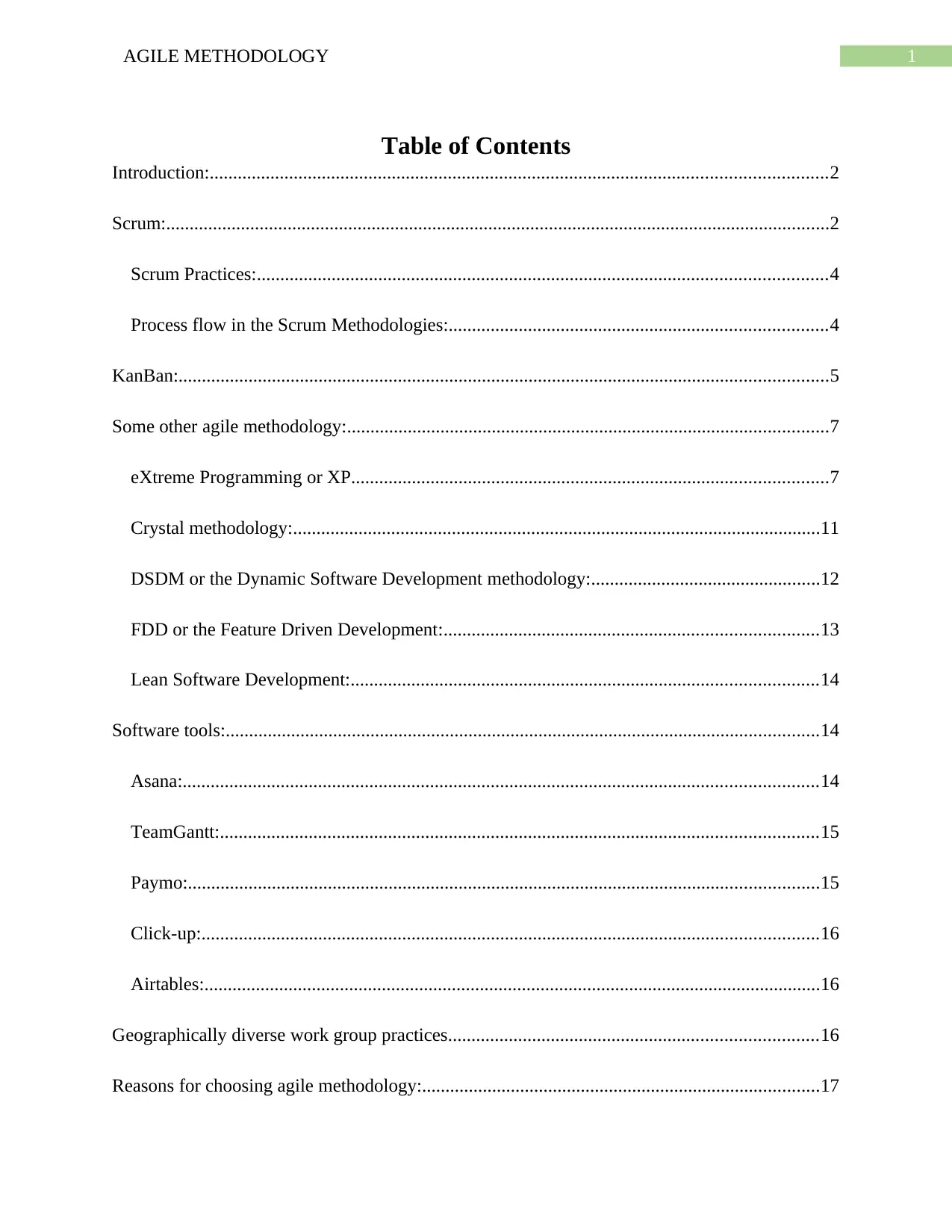
1AGILE METHODOLOGY
Table of Contents
Introduction:....................................................................................................................................2
Scrum:..............................................................................................................................................2
Scrum Practices:..........................................................................................................................4
Process flow in the Scrum Methodologies:.................................................................................4
KanBan:...........................................................................................................................................5
Some other agile methodology:.......................................................................................................7
eXtreme Programming or XP......................................................................................................7
Crystal methodology:.................................................................................................................11
DSDM or the Dynamic Software Development methodology:.................................................12
FDD or the Feature Driven Development:................................................................................13
Lean Software Development:....................................................................................................14
Software tools:...............................................................................................................................14
Asana:........................................................................................................................................14
TeamGantt:................................................................................................................................15
Paymo:.......................................................................................................................................15
Click-up:....................................................................................................................................16
Airtables:....................................................................................................................................16
Geographically diverse work group practices...............................................................................16
Reasons for choosing agile methodology:.....................................................................................17
Table of Contents
Introduction:....................................................................................................................................2
Scrum:..............................................................................................................................................2
Scrum Practices:..........................................................................................................................4
Process flow in the Scrum Methodologies:.................................................................................4
KanBan:...........................................................................................................................................5
Some other agile methodology:.......................................................................................................7
eXtreme Programming or XP......................................................................................................7
Crystal methodology:.................................................................................................................11
DSDM or the Dynamic Software Development methodology:.................................................12
FDD or the Feature Driven Development:................................................................................13
Lean Software Development:....................................................................................................14
Software tools:...............................................................................................................................14
Asana:........................................................................................................................................14
TeamGantt:................................................................................................................................15
Paymo:.......................................................................................................................................15
Click-up:....................................................................................................................................16
Airtables:....................................................................................................................................16
Geographically diverse work group practices...............................................................................16
Reasons for choosing agile methodology:.....................................................................................17
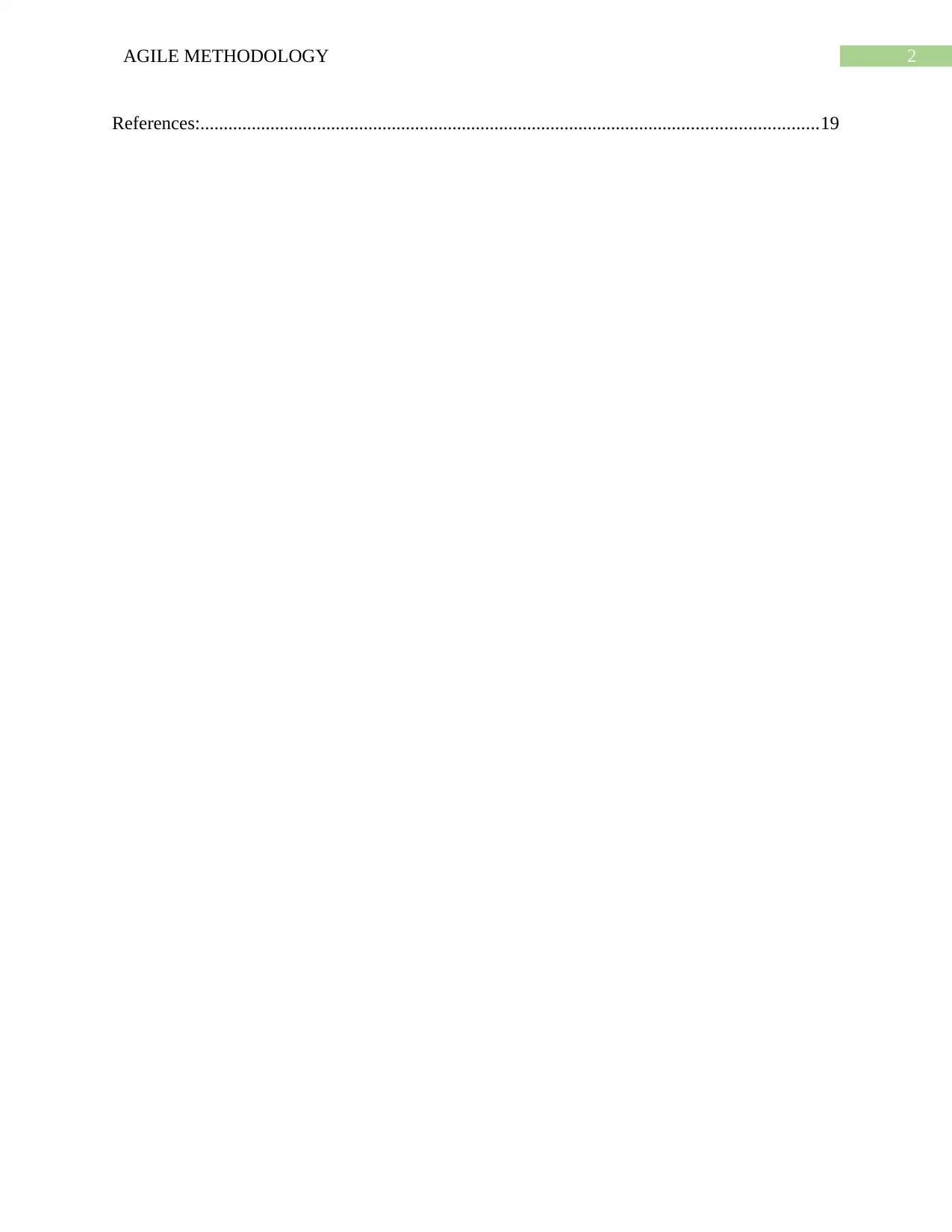
2AGILE METHODOLOGY
References:....................................................................................................................................19
References:....................................................................................................................................19
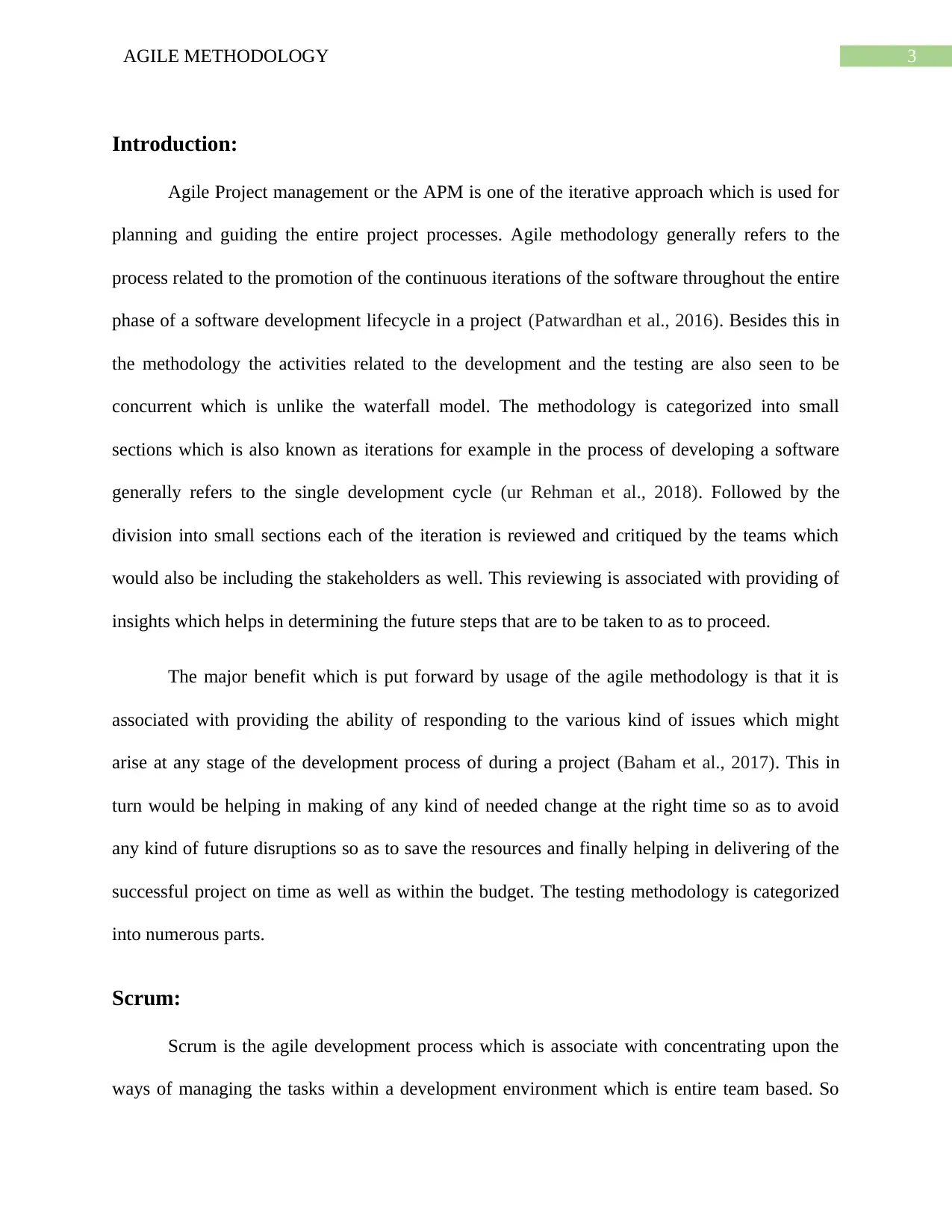
3AGILE METHODOLOGY
Introduction:
Agile Project management or the APM is one of the iterative approach which is used for
planning and guiding the entire project processes. Agile methodology generally refers to the
process related to the promotion of the continuous iterations of the software throughout the entire
phase of a software development lifecycle in a project (Patwardhan et al., 2016). Besides this in
the methodology the activities related to the development and the testing are also seen to be
concurrent which is unlike the waterfall model. The methodology is categorized into small
sections which is also known as iterations for example in the process of developing a software
generally refers to the single development cycle (ur Rehman et al., 2018). Followed by the
division into small sections each of the iteration is reviewed and critiqued by the teams which
would also be including the stakeholders as well. This reviewing is associated with providing of
insights which helps in determining the future steps that are to be taken to as to proceed.
The major benefit which is put forward by usage of the agile methodology is that it is
associated with providing the ability of responding to the various kind of issues which might
arise at any stage of the development process of during a project (Baham et al., 2017). This in
turn would be helping in making of any kind of needed change at the right time so as to avoid
any kind of future disruptions so as to save the resources and finally helping in delivering of the
successful project on time as well as within the budget. The testing methodology is categorized
into numerous parts.
Scrum:
Scrum is the agile development process which is associate with concentrating upon the
ways of managing the tasks within a development environment which is entire team based. So
Introduction:
Agile Project management or the APM is one of the iterative approach which is used for
planning and guiding the entire project processes. Agile methodology generally refers to the
process related to the promotion of the continuous iterations of the software throughout the entire
phase of a software development lifecycle in a project (Patwardhan et al., 2016). Besides this in
the methodology the activities related to the development and the testing are also seen to be
concurrent which is unlike the waterfall model. The methodology is categorized into small
sections which is also known as iterations for example in the process of developing a software
generally refers to the single development cycle (ur Rehman et al., 2018). Followed by the
division into small sections each of the iteration is reviewed and critiqued by the teams which
would also be including the stakeholders as well. This reviewing is associated with providing of
insights which helps in determining the future steps that are to be taken to as to proceed.
The major benefit which is put forward by usage of the agile methodology is that it is
associated with providing the ability of responding to the various kind of issues which might
arise at any stage of the development process of during a project (Baham et al., 2017). This in
turn would be helping in making of any kind of needed change at the right time so as to avoid
any kind of future disruptions so as to save the resources and finally helping in delivering of the
successful project on time as well as within the budget. The testing methodology is categorized
into numerous parts.
Scrum:
Scrum is the agile development process which is associate with concentrating upon the
ways of managing the tasks within a development environment which is entire team based. So
Secure Best Marks with AI Grader
Need help grading? Try our AI Grader for instant feedback on your assignments.
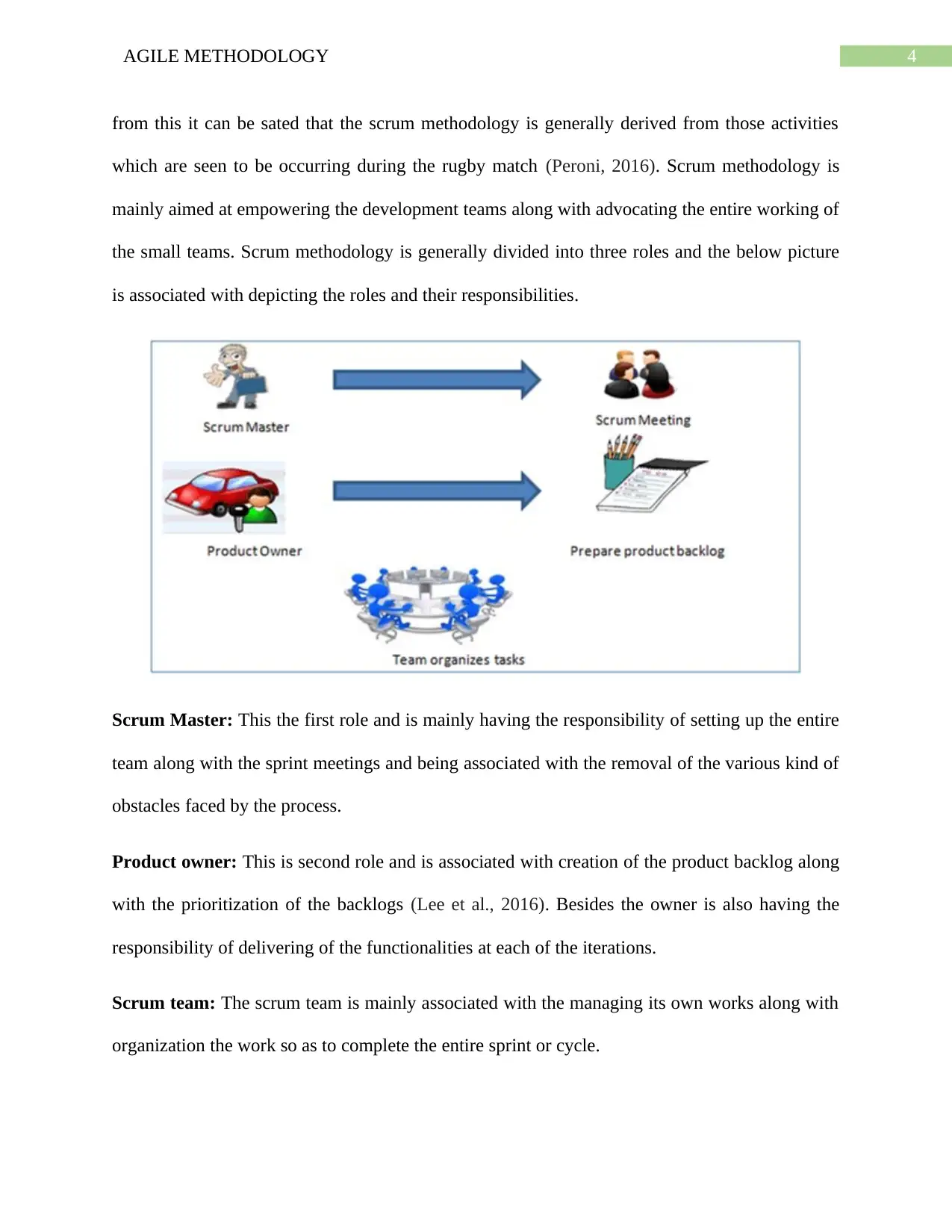
4AGILE METHODOLOGY
from this it can be sated that the scrum methodology is generally derived from those activities
which are seen to be occurring during the rugby match (Peroni, 2016). Scrum methodology is
mainly aimed at empowering the development teams along with advocating the entire working of
the small teams. Scrum methodology is generally divided into three roles and the below picture
is associated with depicting the roles and their responsibilities.
Scrum Master: This the first role and is mainly having the responsibility of setting up the entire
team along with the sprint meetings and being associated with the removal of the various kind of
obstacles faced by the process.
Product owner: This is second role and is associated with creation of the product backlog along
with the prioritization of the backlogs (Lee et al., 2016). Besides the owner is also having the
responsibility of delivering of the functionalities at each of the iterations.
Scrum team: The scrum team is mainly associated with the managing its own works along with
organization the work so as to complete the entire sprint or cycle.
from this it can be sated that the scrum methodology is generally derived from those activities
which are seen to be occurring during the rugby match (Peroni, 2016). Scrum methodology is
mainly aimed at empowering the development teams along with advocating the entire working of
the small teams. Scrum methodology is generally divided into three roles and the below picture
is associated with depicting the roles and their responsibilities.
Scrum Master: This the first role and is mainly having the responsibility of setting up the entire
team along with the sprint meetings and being associated with the removal of the various kind of
obstacles faced by the process.
Product owner: This is second role and is associated with creation of the product backlog along
with the prioritization of the backlogs (Lee et al., 2016). Besides the owner is also having the
responsibility of delivering of the functionalities at each of the iterations.
Scrum team: The scrum team is mainly associated with the managing its own works along with
organization the work so as to complete the entire sprint or cycle.
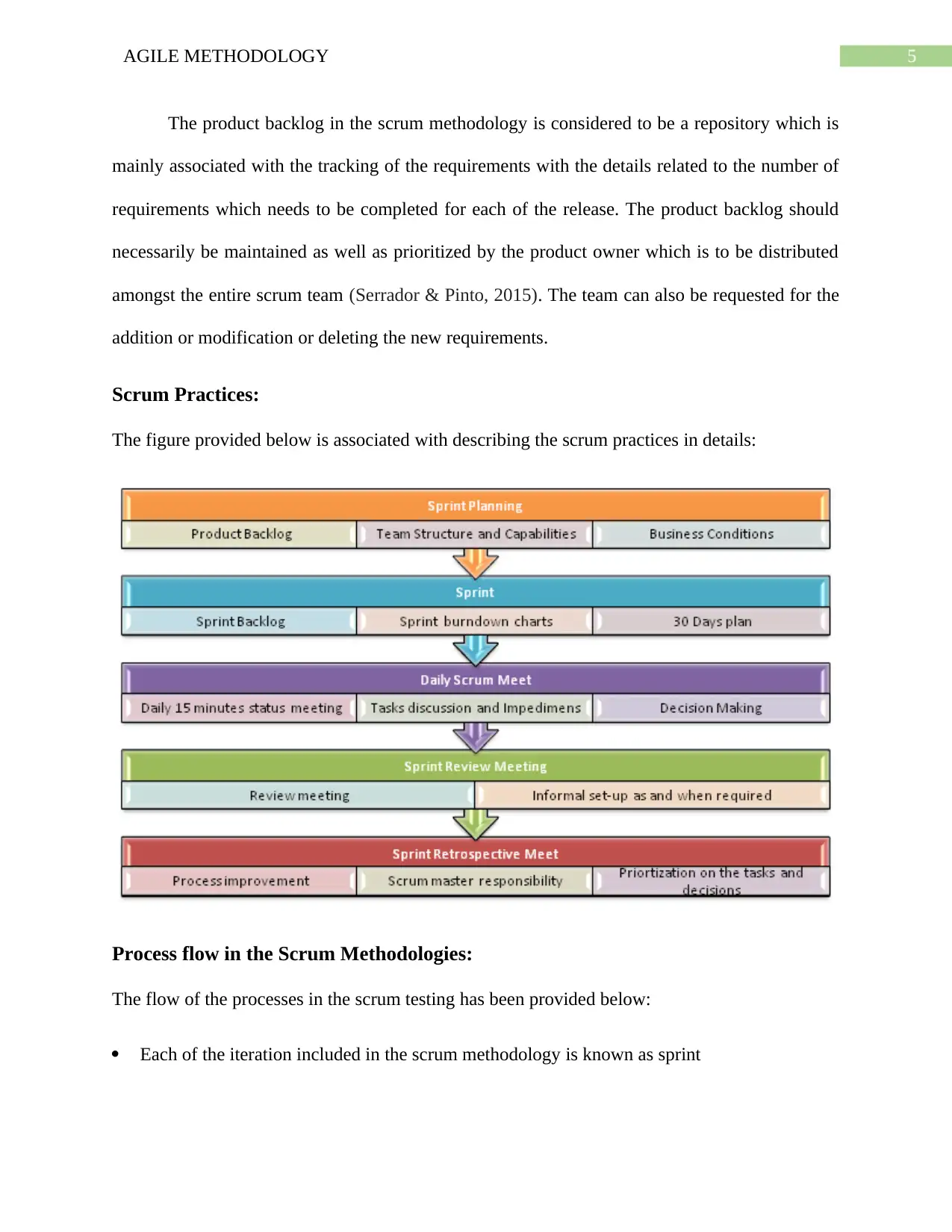
5AGILE METHODOLOGY
The product backlog in the scrum methodology is considered to be a repository which is
mainly associated with the tracking of the requirements with the details related to the number of
requirements which needs to be completed for each of the release. The product backlog should
necessarily be maintained as well as prioritized by the product owner which is to be distributed
amongst the entire scrum team (Serrador & Pinto, 2015). The team can also be requested for the
addition or modification or deleting the new requirements.
Scrum Practices:
The figure provided below is associated with describing the scrum practices in details:
Process flow in the Scrum Methodologies:
The flow of the processes in the scrum testing has been provided below:
Each of the iteration included in the scrum methodology is known as sprint
The product backlog in the scrum methodology is considered to be a repository which is
mainly associated with the tracking of the requirements with the details related to the number of
requirements which needs to be completed for each of the release. The product backlog should
necessarily be maintained as well as prioritized by the product owner which is to be distributed
amongst the entire scrum team (Serrador & Pinto, 2015). The team can also be requested for the
addition or modification or deleting the new requirements.
Scrum Practices:
The figure provided below is associated with describing the scrum practices in details:
Process flow in the Scrum Methodologies:
The flow of the processes in the scrum testing has been provided below:
Each of the iteration included in the scrum methodology is known as sprint
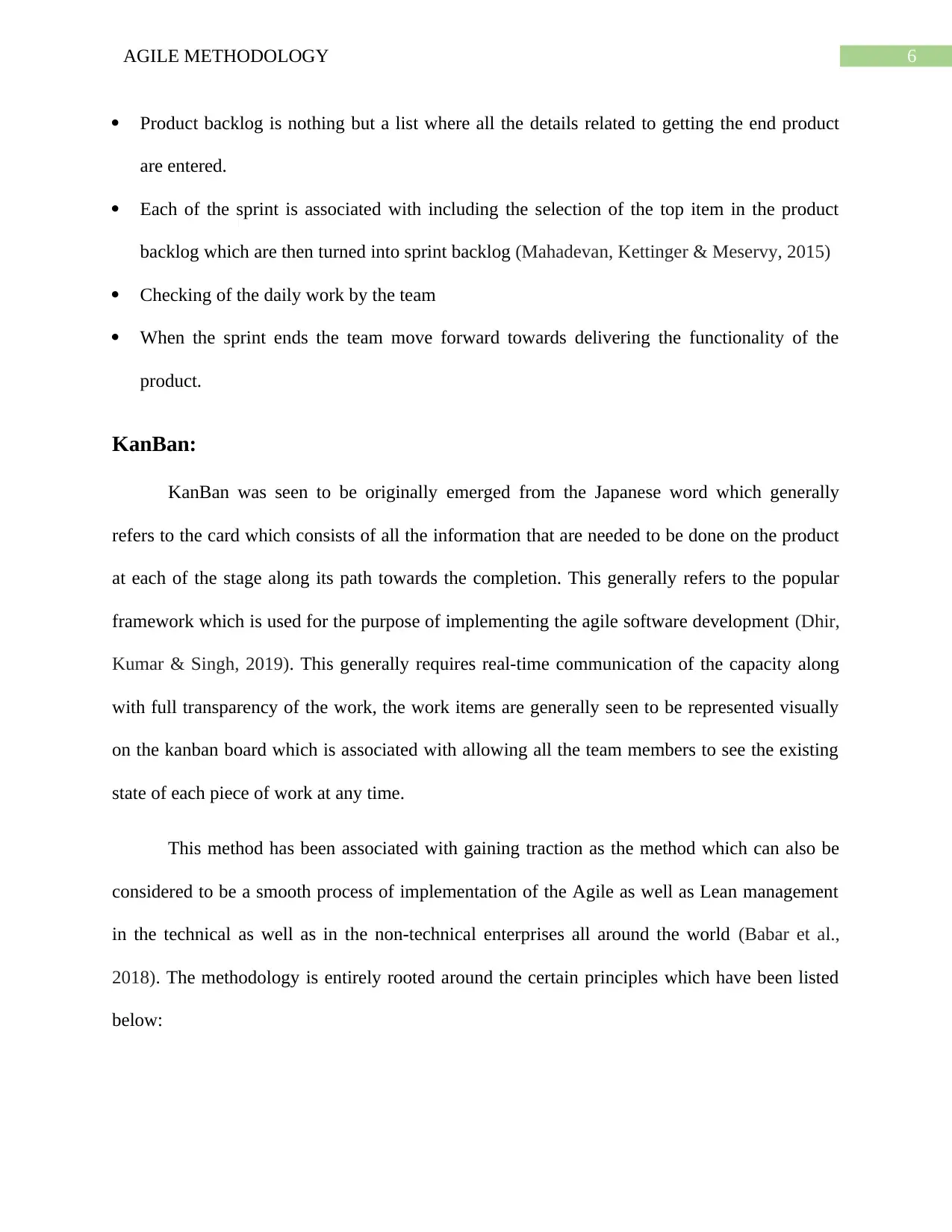
6AGILE METHODOLOGY
Product backlog is nothing but a list where all the details related to getting the end product
are entered.
Each of the sprint is associated with including the selection of the top item in the product
backlog which are then turned into sprint backlog (Mahadevan, Kettinger & Meservy, 2015)
Checking of the daily work by the team
When the sprint ends the team move forward towards delivering the functionality of the
product.
KanBan:
KanBan was seen to be originally emerged from the Japanese word which generally
refers to the card which consists of all the information that are needed to be done on the product
at each of the stage along its path towards the completion. This generally refers to the popular
framework which is used for the purpose of implementing the agile software development (Dhir,
Kumar & Singh, 2019). This generally requires real-time communication of the capacity along
with full transparency of the work, the work items are generally seen to be represented visually
on the kanban board which is associated with allowing all the team members to see the existing
state of each piece of work at any time.
This method has been associated with gaining traction as the method which can also be
considered to be a smooth process of implementation of the Agile as well as Lean management
in the technical as well as in the non-technical enterprises all around the world (Babar et al.,
2018). The methodology is entirely rooted around the certain principles which have been listed
below:
Product backlog is nothing but a list where all the details related to getting the end product
are entered.
Each of the sprint is associated with including the selection of the top item in the product
backlog which are then turned into sprint backlog (Mahadevan, Kettinger & Meservy, 2015)
Checking of the daily work by the team
When the sprint ends the team move forward towards delivering the functionality of the
product.
KanBan:
KanBan was seen to be originally emerged from the Japanese word which generally
refers to the card which consists of all the information that are needed to be done on the product
at each of the stage along its path towards the completion. This generally refers to the popular
framework which is used for the purpose of implementing the agile software development (Dhir,
Kumar & Singh, 2019). This generally requires real-time communication of the capacity along
with full transparency of the work, the work items are generally seen to be represented visually
on the kanban board which is associated with allowing all the team members to see the existing
state of each piece of work at any time.
This method has been associated with gaining traction as the method which can also be
considered to be a smooth process of implementation of the Agile as well as Lean management
in the technical as well as in the non-technical enterprises all around the world (Babar et al.,
2018). The methodology is entirely rooted around the certain principles which have been listed
below:
Paraphrase This Document
Need a fresh take? Get an instant paraphrase of this document with our AI Paraphraser
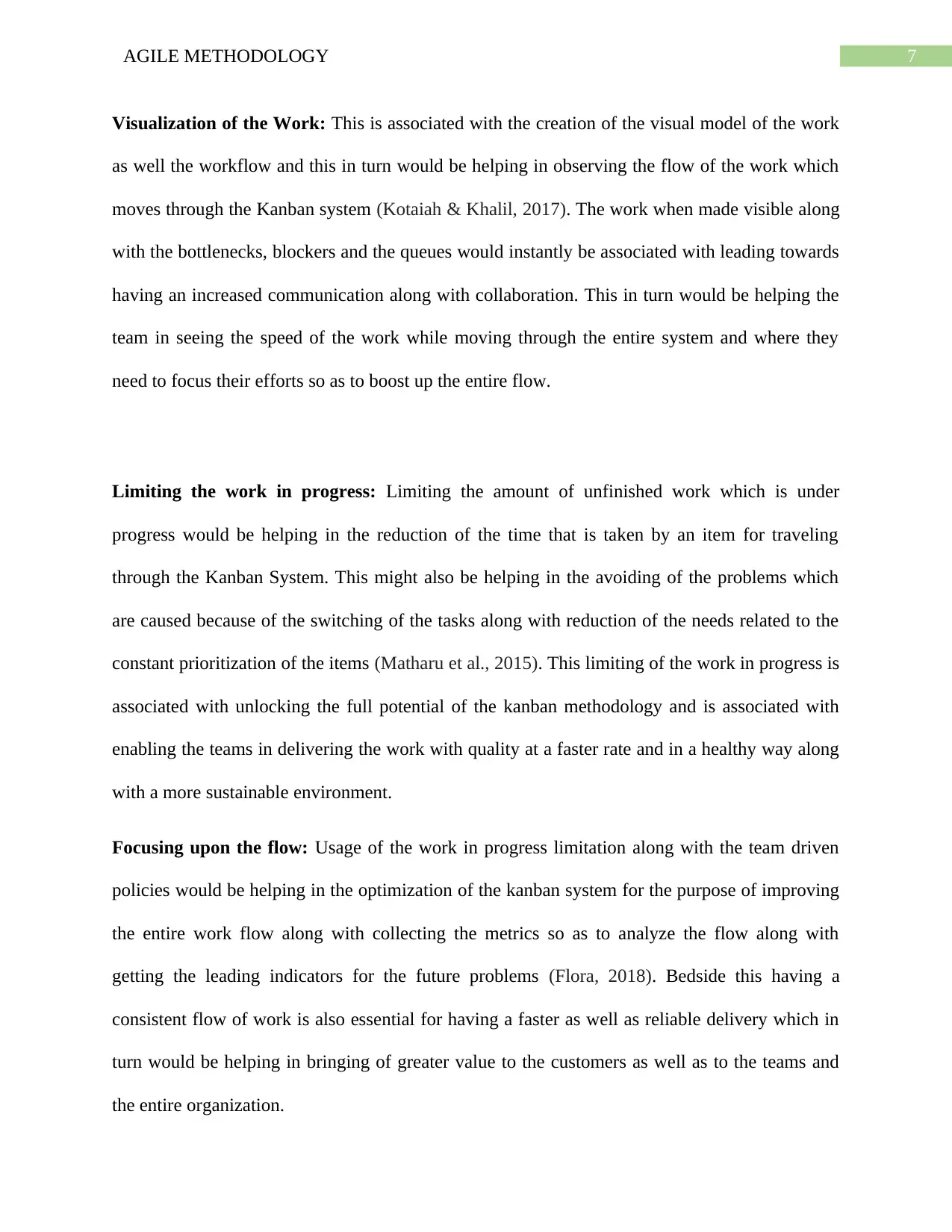
7AGILE METHODOLOGY
Visualization of the Work: This is associated with the creation of the visual model of the work
as well the workflow and this in turn would be helping in observing the flow of the work which
moves through the Kanban system (Kotaiah & Khalil, 2017). The work when made visible along
with the bottlenecks, blockers and the queues would instantly be associated with leading towards
having an increased communication along with collaboration. This in turn would be helping the
team in seeing the speed of the work while moving through the entire system and where they
need to focus their efforts so as to boost up the entire flow.
Limiting the work in progress: Limiting the amount of unfinished work which is under
progress would be helping in the reduction of the time that is taken by an item for traveling
through the Kanban System. This might also be helping in the avoiding of the problems which
are caused because of the switching of the tasks along with reduction of the needs related to the
constant prioritization of the items (Matharu et al., 2015). This limiting of the work in progress is
associated with unlocking the full potential of the kanban methodology and is associated with
enabling the teams in delivering the work with quality at a faster rate and in a healthy way along
with a more sustainable environment.
Focusing upon the flow: Usage of the work in progress limitation along with the team driven
policies would be helping in the optimization of the kanban system for the purpose of improving
the entire work flow along with collecting the metrics so as to analyze the flow along with
getting the leading indicators for the future problems (Flora, 2018). Bedside this having a
consistent flow of work is also essential for having a faster as well as reliable delivery which in
turn would be helping in bringing of greater value to the customers as well as to the teams and
the entire organization.
Visualization of the Work: This is associated with the creation of the visual model of the work
as well the workflow and this in turn would be helping in observing the flow of the work which
moves through the Kanban system (Kotaiah & Khalil, 2017). The work when made visible along
with the bottlenecks, blockers and the queues would instantly be associated with leading towards
having an increased communication along with collaboration. This in turn would be helping the
team in seeing the speed of the work while moving through the entire system and where they
need to focus their efforts so as to boost up the entire flow.
Limiting the work in progress: Limiting the amount of unfinished work which is under
progress would be helping in the reduction of the time that is taken by an item for traveling
through the Kanban System. This might also be helping in the avoiding of the problems which
are caused because of the switching of the tasks along with reduction of the needs related to the
constant prioritization of the items (Matharu et al., 2015). This limiting of the work in progress is
associated with unlocking the full potential of the kanban methodology and is associated with
enabling the teams in delivering the work with quality at a faster rate and in a healthy way along
with a more sustainable environment.
Focusing upon the flow: Usage of the work in progress limitation along with the team driven
policies would be helping in the optimization of the kanban system for the purpose of improving
the entire work flow along with collecting the metrics so as to analyze the flow along with
getting the leading indicators for the future problems (Flora, 2018). Bedside this having a
consistent flow of work is also essential for having a faster as well as reliable delivery which in
turn would be helping in bringing of greater value to the customers as well as to the teams and
the entire organization.
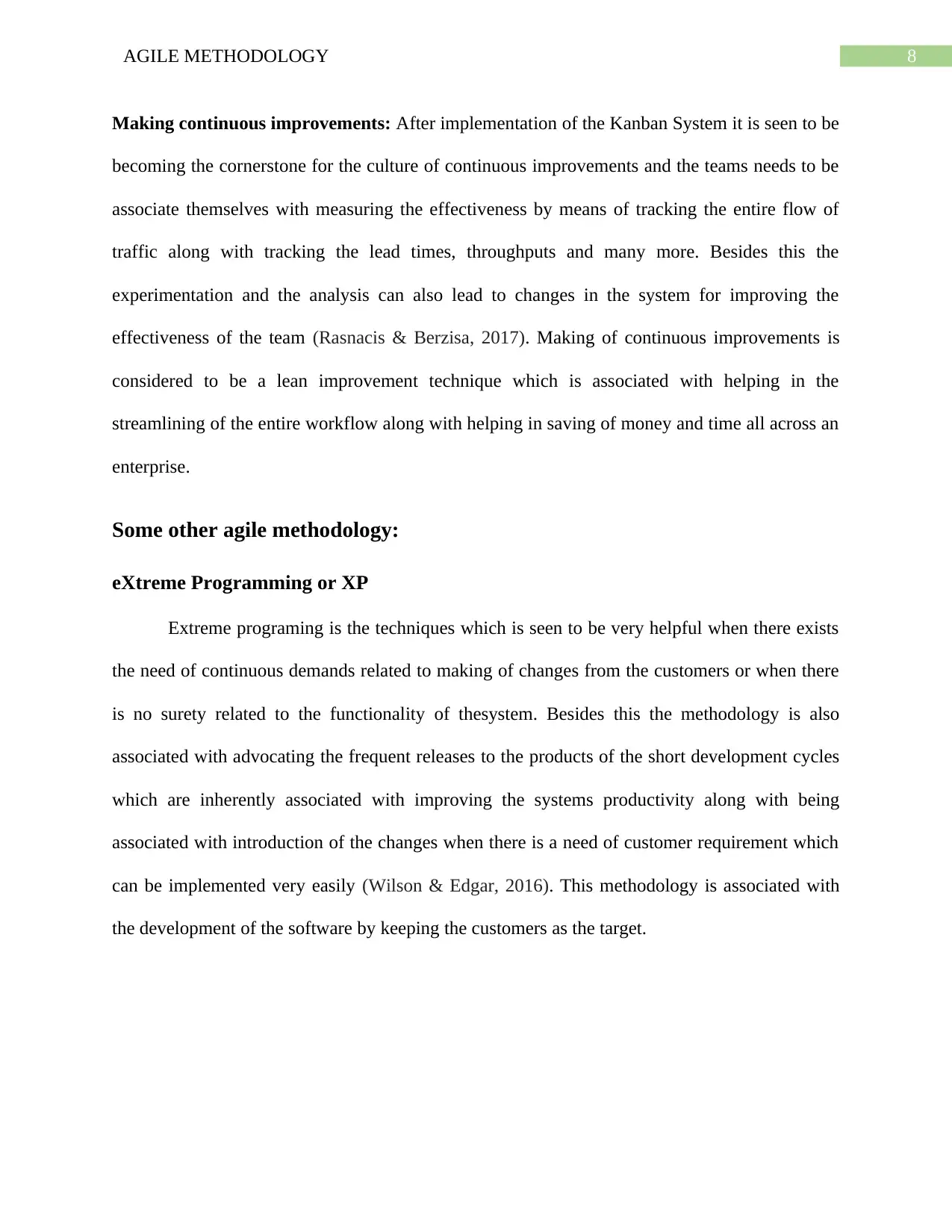
8AGILE METHODOLOGY
Making continuous improvements: After implementation of the Kanban System it is seen to be
becoming the cornerstone for the culture of continuous improvements and the teams needs to be
associate themselves with measuring the effectiveness by means of tracking the entire flow of
traffic along with tracking the lead times, throughputs and many more. Besides this the
experimentation and the analysis can also lead to changes in the system for improving the
effectiveness of the team (Rasnacis & Berzisa, 2017). Making of continuous improvements is
considered to be a lean improvement technique which is associated with helping in the
streamlining of the entire workflow along with helping in saving of money and time all across an
enterprise.
Some other agile methodology:
eXtreme Programming or XP
Extreme programing is the techniques which is seen to be very helpful when there exists
the need of continuous demands related to making of changes from the customers or when there
is no surety related to the functionality of thesystem. Besides this the methodology is also
associated with advocating the frequent releases to the products of the short development cycles
which are inherently associated with improving the systems productivity along with being
associated with introduction of the changes when there is a need of customer requirement which
can be implemented very easily (Wilson & Edgar, 2016). This methodology is associated with
the development of the software by keeping the customers as the target.
Making continuous improvements: After implementation of the Kanban System it is seen to be
becoming the cornerstone for the culture of continuous improvements and the teams needs to be
associate themselves with measuring the effectiveness by means of tracking the entire flow of
traffic along with tracking the lead times, throughputs and many more. Besides this the
experimentation and the analysis can also lead to changes in the system for improving the
effectiveness of the team (Rasnacis & Berzisa, 2017). Making of continuous improvements is
considered to be a lean improvement technique which is associated with helping in the
streamlining of the entire workflow along with helping in saving of money and time all across an
enterprise.
Some other agile methodology:
eXtreme Programming or XP
Extreme programing is the techniques which is seen to be very helpful when there exists
the need of continuous demands related to making of changes from the customers or when there
is no surety related to the functionality of thesystem. Besides this the methodology is also
associated with advocating the frequent releases to the products of the short development cycles
which are inherently associated with improving the systems productivity along with being
associated with introduction of the changes when there is a need of customer requirement which
can be implemented very easily (Wilson & Edgar, 2016). This methodology is associated with
the development of the software by keeping the customers as the target.

9AGILE METHODOLOGY
The business requirements are gathered by considering the stories and all this stories are
seen to be placed in a place which is known as the parking lot. This type of methodology is
associated with including the release which are dependent upon short cycles known as the
iterations which is having a time span of 14 days (Larson & Chang, 2016). Each and every
iteration is associated with including the phases such as the coding, unit testing and testing of the
system in which each phase is having minor as well as major functionalities which would be
built in the application.
Phases of eXtreme programming:
The agile XP methodology can be categorized into 6 phases which includes the following:
1. Planning
Stakeholders along with the sponsors are identified
Requirements related to the Infrastructure
The business requirements are gathered by considering the stories and all this stories are
seen to be placed in a place which is known as the parking lot. This type of methodology is
associated with including the release which are dependent upon short cycles known as the
iterations which is having a time span of 14 days (Larson & Chang, 2016). Each and every
iteration is associated with including the phases such as the coding, unit testing and testing of the
system in which each phase is having minor as well as major functionalities which would be
built in the application.
Phases of eXtreme programming:
The agile XP methodology can be categorized into 6 phases which includes the following:
1. Planning
Stakeholders along with the sponsors are identified
Requirements related to the Infrastructure
Secure Best Marks with AI Grader
Need help grading? Try our AI Grader for instant feedback on your assignments.

10AGILE METHODOLOGY
Gathering of the information related to security
SLA or the Service Level Agreements along with its conditions
2. Analysis
Stories are captured in the Parking lot
Prioritization of the stories in Parking lot
Stories are scribed for making estimation
Defining the Iteration SPAN(Time)
Planning for the resources needed by the Development and QA teams
3. Design
Task Break down
Preparation of Test Scenario in each task
Regression Automation Framework
4. Execution
Unit Testing
Coding
Manual test scenarios are executed
Generation of Defect Report
Conversion of the regression test cases from Manual to Automation
Gathering of the information related to security
SLA or the Service Level Agreements along with its conditions
2. Analysis
Stories are captured in the Parking lot
Prioritization of the stories in Parking lot
Stories are scribed for making estimation
Defining the Iteration SPAN(Time)
Planning for the resources needed by the Development and QA teams
3. Design
Task Break down
Preparation of Test Scenario in each task
Regression Automation Framework
4. Execution
Unit Testing
Coding
Manual test scenarios are executed
Generation of Defect Report
Conversion of the regression test cases from Manual to Automation
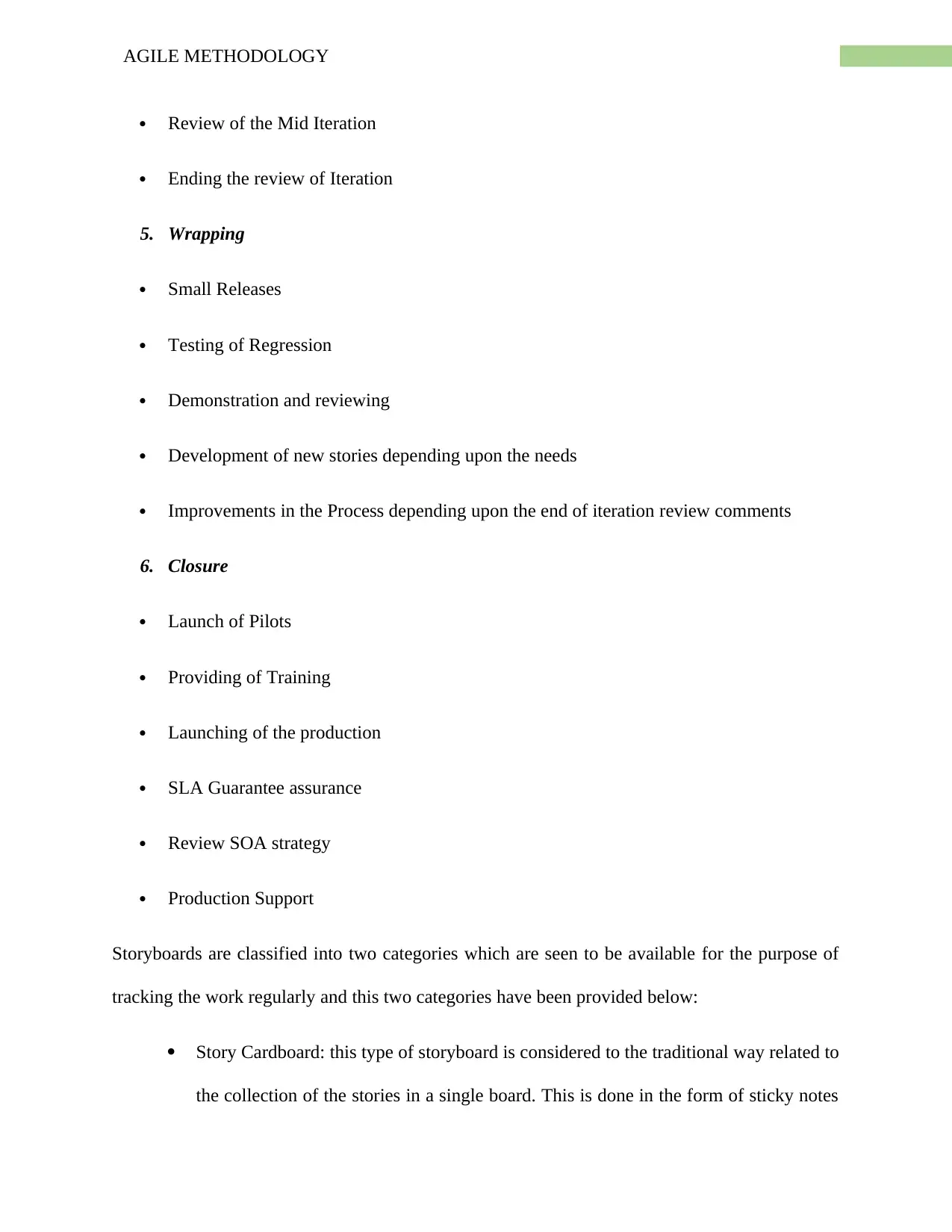
11AGILE METHODOLOGY
Review of the Mid Iteration
Ending the review of Iteration
5. Wrapping
Small Releases
Testing of Regression
Demonstration and reviewing
Development of new stories depending upon the needs
Improvements in the Process depending upon the end of iteration review comments
6. Closure
Launch of Pilots
Providing of Training
Launching of the production
SLA Guarantee assurance
Review SOA strategy
Production Support
Storyboards are classified into two categories which are seen to be available for the purpose of
tracking the work regularly and this two categories have been provided below:
Story Cardboard: this type of storyboard is considered to the traditional way related to
the collection of the stories in a single board. This is done in the form of sticky notes
Review of the Mid Iteration
Ending the review of Iteration
5. Wrapping
Small Releases
Testing of Regression
Demonstration and reviewing
Development of new stories depending upon the needs
Improvements in the Process depending upon the end of iteration review comments
6. Closure
Launch of Pilots
Providing of Training
Launching of the production
SLA Guarantee assurance
Review SOA strategy
Production Support
Storyboards are classified into two categories which are seen to be available for the purpose of
tracking the work regularly and this two categories have been provided below:
Story Cardboard: this type of storyboard is considered to the traditional way related to
the collection of the stories in a single board. This is done in the form of sticky notes
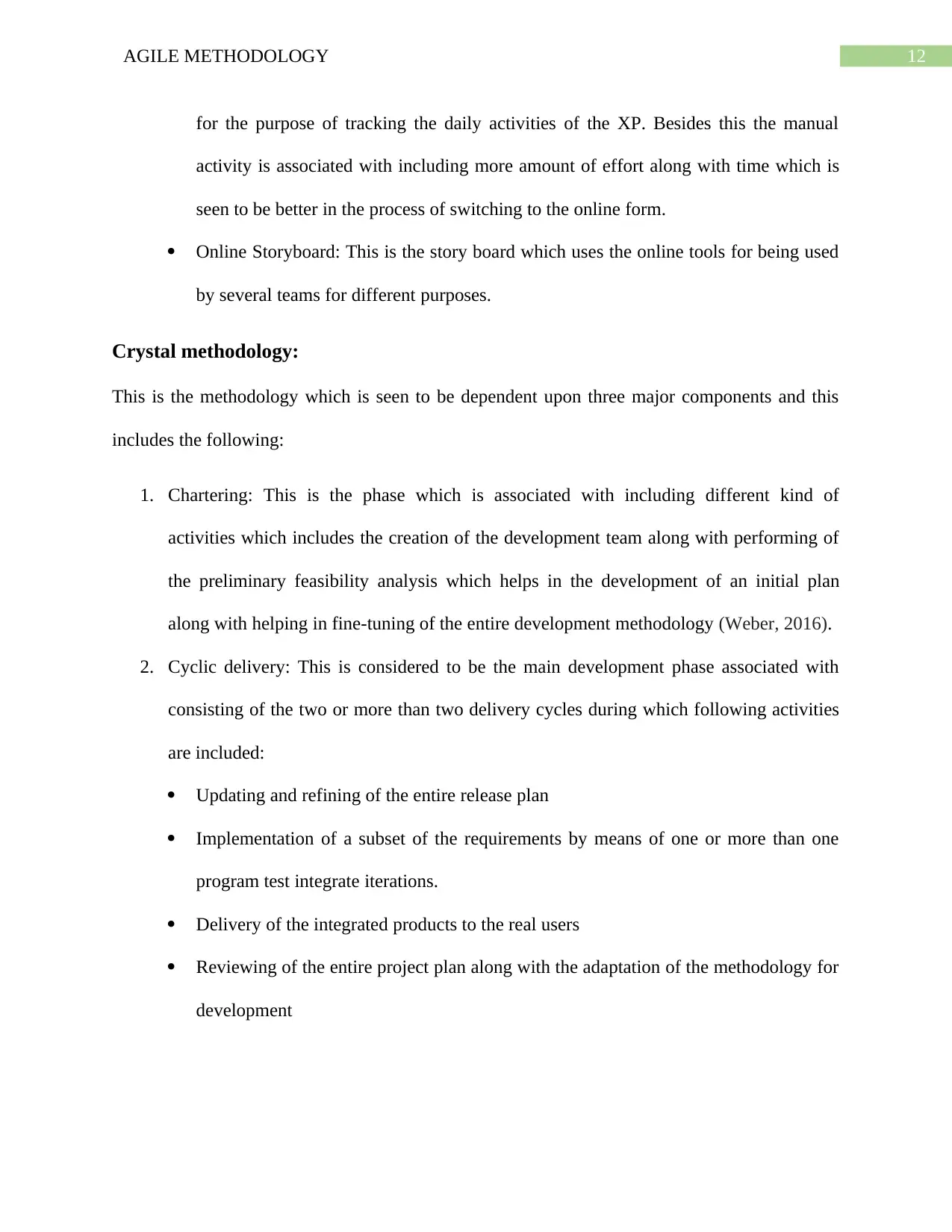
12AGILE METHODOLOGY
for the purpose of tracking the daily activities of the XP. Besides this the manual
activity is associated with including more amount of effort along with time which is
seen to be better in the process of switching to the online form.
Online Storyboard: This is the story board which uses the online tools for being used
by several teams for different purposes.
Crystal methodology:
This is the methodology which is seen to be dependent upon three major components and this
includes the following:
1. Chartering: This is the phase which is associated with including different kind of
activities which includes the creation of the development team along with performing of
the preliminary feasibility analysis which helps in the development of an initial plan
along with helping in fine-tuning of the entire development methodology (Weber, 2016).
2. Cyclic delivery: This is considered to be the main development phase associated with
consisting of the two or more than two delivery cycles during which following activities
are included:
Updating and refining of the entire release plan
Implementation of a subset of the requirements by means of one or more than one
program test integrate iterations.
Delivery of the integrated products to the real users
Reviewing of the entire project plan along with the adaptation of the methodology for
development
for the purpose of tracking the daily activities of the XP. Besides this the manual
activity is associated with including more amount of effort along with time which is
seen to be better in the process of switching to the online form.
Online Storyboard: This is the story board which uses the online tools for being used
by several teams for different purposes.
Crystal methodology:
This is the methodology which is seen to be dependent upon three major components and this
includes the following:
1. Chartering: This is the phase which is associated with including different kind of
activities which includes the creation of the development team along with performing of
the preliminary feasibility analysis which helps in the development of an initial plan
along with helping in fine-tuning of the entire development methodology (Weber, 2016).
2. Cyclic delivery: This is considered to be the main development phase associated with
consisting of the two or more than two delivery cycles during which following activities
are included:
Updating and refining of the entire release plan
Implementation of a subset of the requirements by means of one or more than one
program test integrate iterations.
Delivery of the integrated products to the real users
Reviewing of the entire project plan along with the adaptation of the methodology for
development
Paraphrase This Document
Need a fresh take? Get an instant paraphrase of this document with our AI Paraphraser
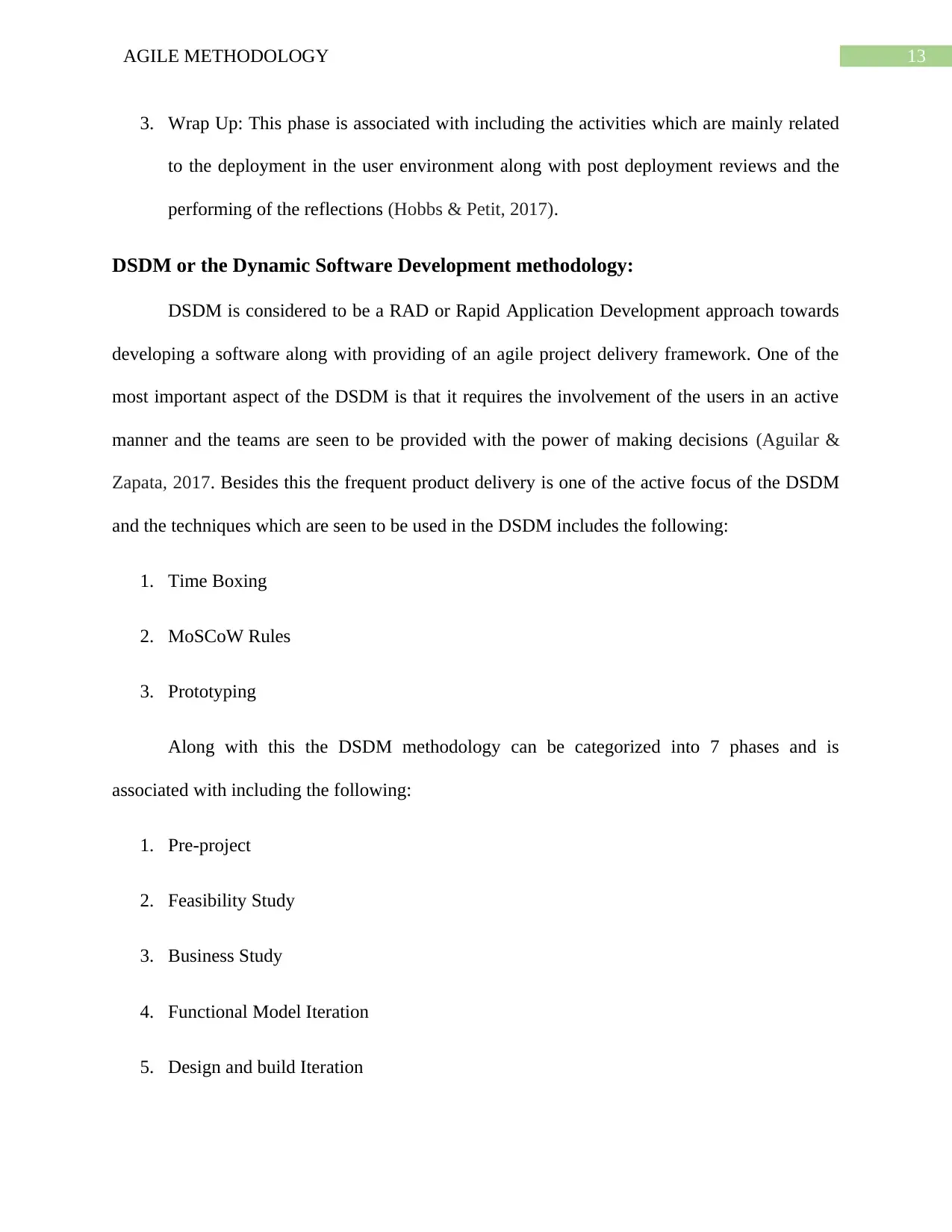
13AGILE METHODOLOGY
3. Wrap Up: This phase is associated with including the activities which are mainly related
to the deployment in the user environment along with post deployment reviews and the
performing of the reflections (Hobbs & Petit, 2017).
DSDM or the Dynamic Software Development methodology:
DSDM is considered to be a RAD or Rapid Application Development approach towards
developing a software along with providing of an agile project delivery framework. One of the
most important aspect of the DSDM is that it requires the involvement of the users in an active
manner and the teams are seen to be provided with the power of making decisions (Aguilar &
Zapata, 2017. Besides this the frequent product delivery is one of the active focus of the DSDM
and the techniques which are seen to be used in the DSDM includes the following:
1. Time Boxing
2. MoSCoW Rules
3. Prototyping
Along with this the DSDM methodology can be categorized into 7 phases and is
associated with including the following:
1. Pre-project
2. Feasibility Study
3. Business Study
4. Functional Model Iteration
5. Design and build Iteration
3. Wrap Up: This phase is associated with including the activities which are mainly related
to the deployment in the user environment along with post deployment reviews and the
performing of the reflections (Hobbs & Petit, 2017).
DSDM or the Dynamic Software Development methodology:
DSDM is considered to be a RAD or Rapid Application Development approach towards
developing a software along with providing of an agile project delivery framework. One of the
most important aspect of the DSDM is that it requires the involvement of the users in an active
manner and the teams are seen to be provided with the power of making decisions (Aguilar &
Zapata, 2017. Besides this the frequent product delivery is one of the active focus of the DSDM
and the techniques which are seen to be used in the DSDM includes the following:
1. Time Boxing
2. MoSCoW Rules
3. Prototyping
Along with this the DSDM methodology can be categorized into 7 phases and is
associated with including the following:
1. Pre-project
2. Feasibility Study
3. Business Study
4. Functional Model Iteration
5. Design and build Iteration
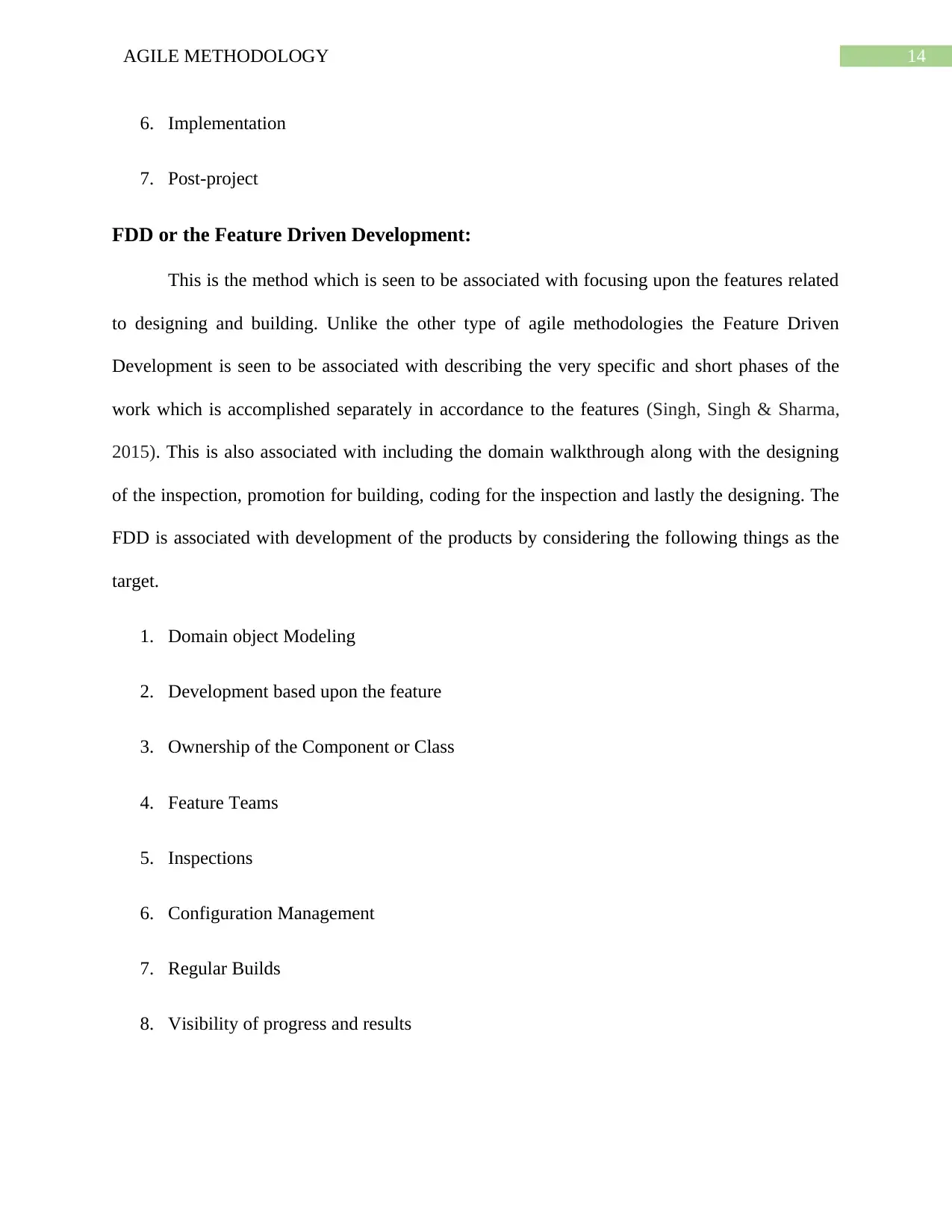
14AGILE METHODOLOGY
6. Implementation
7. Post-project
FDD or the Feature Driven Development:
This is the method which is seen to be associated with focusing upon the features related
to designing and building. Unlike the other type of agile methodologies the Feature Driven
Development is seen to be associated with describing the very specific and short phases of the
work which is accomplished separately in accordance to the features (Singh, Singh & Sharma,
2015). This is also associated with including the domain walkthrough along with the designing
of the inspection, promotion for building, coding for the inspection and lastly the designing. The
FDD is associated with development of the products by considering the following things as the
target.
1. Domain object Modeling
2. Development based upon the feature
3. Ownership of the Component or Class
4. Feature Teams
5. Inspections
6. Configuration Management
7. Regular Builds
8. Visibility of progress and results
6. Implementation
7. Post-project
FDD or the Feature Driven Development:
This is the method which is seen to be associated with focusing upon the features related
to designing and building. Unlike the other type of agile methodologies the Feature Driven
Development is seen to be associated with describing the very specific and short phases of the
work which is accomplished separately in accordance to the features (Singh, Singh & Sharma,
2015). This is also associated with including the domain walkthrough along with the designing
of the inspection, promotion for building, coding for the inspection and lastly the designing. The
FDD is associated with development of the products by considering the following things as the
target.
1. Domain object Modeling
2. Development based upon the feature
3. Ownership of the Component or Class
4. Feature Teams
5. Inspections
6. Configuration Management
7. Regular Builds
8. Visibility of progress and results
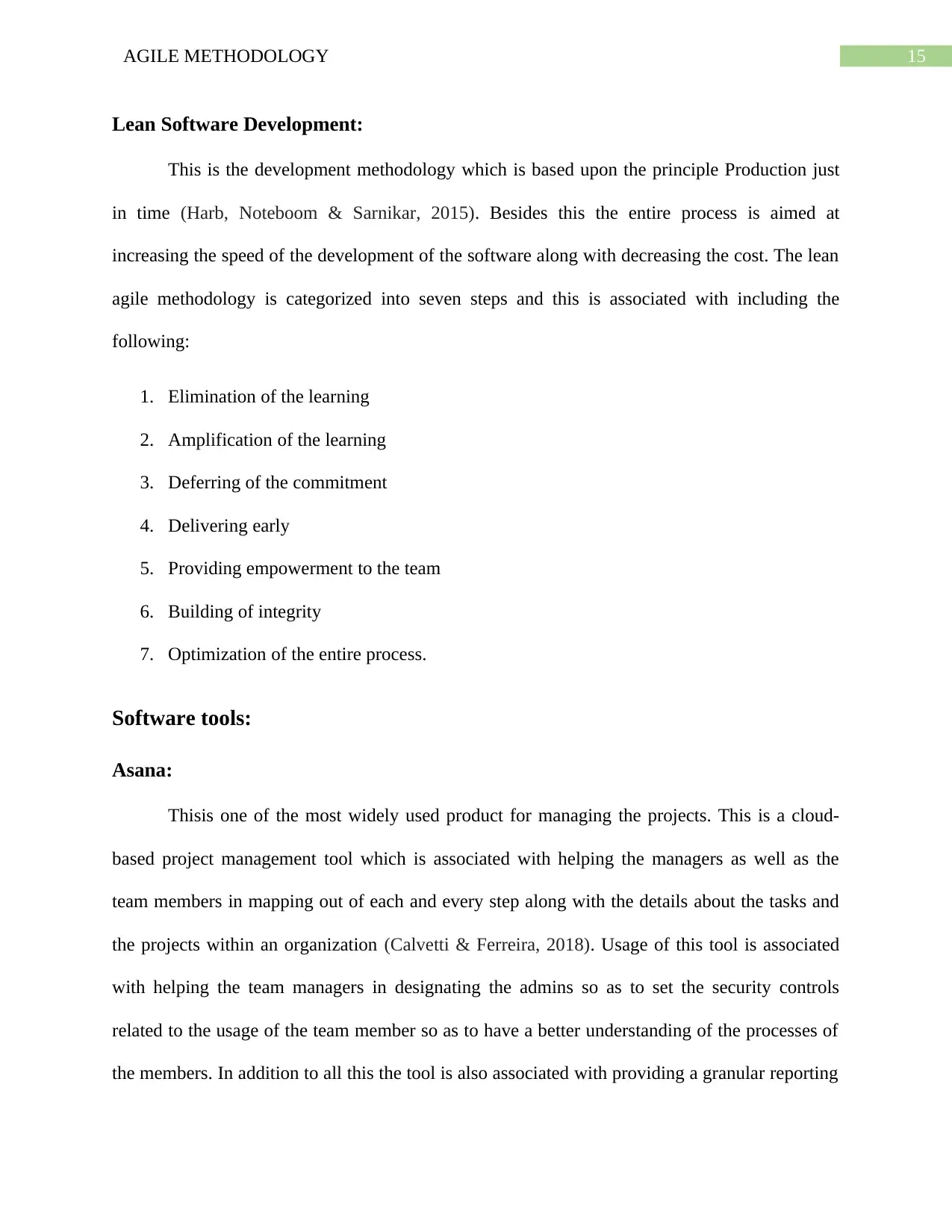
15AGILE METHODOLOGY
Lean Software Development:
This is the development methodology which is based upon the principle Production just
in time (Harb, Noteboom & Sarnikar, 2015). Besides this the entire process is aimed at
increasing the speed of the development of the software along with decreasing the cost. The lean
agile methodology is categorized into seven steps and this is associated with including the
following:
1. Elimination of the learning
2. Amplification of the learning
3. Deferring of the commitment
4. Delivering early
5. Providing empowerment to the team
6. Building of integrity
7. Optimization of the entire process.
Software tools:
Asana:
Thisis one of the most widely used product for managing the projects. This is a cloud-
based project management tool which is associated with helping the managers as well as the
team members in mapping out of each and every step along with the details about the tasks and
the projects within an organization (Calvetti & Ferreira, 2018). Usage of this tool is associated
with helping the team managers in designating the admins so as to set the security controls
related to the usage of the team member so as to have a better understanding of the processes of
the members. In addition to all this the tool is also associated with providing a granular reporting
Lean Software Development:
This is the development methodology which is based upon the principle Production just
in time (Harb, Noteboom & Sarnikar, 2015). Besides this the entire process is aimed at
increasing the speed of the development of the software along with decreasing the cost. The lean
agile methodology is categorized into seven steps and this is associated with including the
following:
1. Elimination of the learning
2. Amplification of the learning
3. Deferring of the commitment
4. Delivering early
5. Providing empowerment to the team
6. Building of integrity
7. Optimization of the entire process.
Software tools:
Asana:
Thisis one of the most widely used product for managing the projects. This is a cloud-
based project management tool which is associated with helping the managers as well as the
team members in mapping out of each and every step along with the details about the tasks and
the projects within an organization (Calvetti & Ferreira, 2018). Usage of this tool is associated
with helping the team managers in designating the admins so as to set the security controls
related to the usage of the team member so as to have a better understanding of the processes of
the members. In addition to all this the tool is also associated with providing a granular reporting
Secure Best Marks with AI Grader
Need help grading? Try our AI Grader for instant feedback on your assignments.
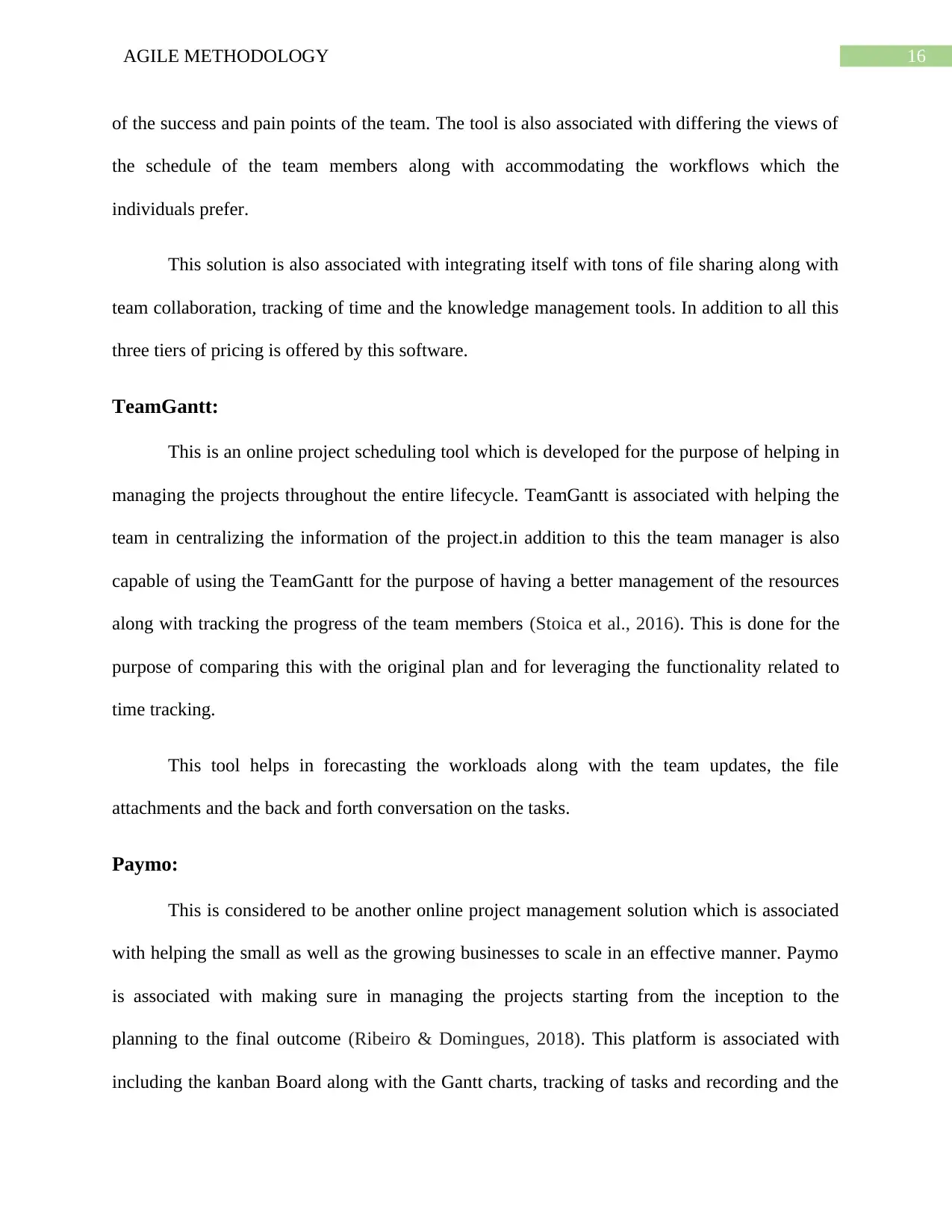
16AGILE METHODOLOGY
of the success and pain points of the team. The tool is also associated with differing the views of
the schedule of the team members along with accommodating the workflows which the
individuals prefer.
This solution is also associated with integrating itself with tons of file sharing along with
team collaboration, tracking of time and the knowledge management tools. In addition to all this
three tiers of pricing is offered by this software.
TeamGantt:
This is an online project scheduling tool which is developed for the purpose of helping in
managing the projects throughout the entire lifecycle. TeamGantt is associated with helping the
team in centralizing the information of the project.in addition to this the team manager is also
capable of using the TeamGantt for the purpose of having a better management of the resources
along with tracking the progress of the team members (Stoica et al., 2016). This is done for the
purpose of comparing this with the original plan and for leveraging the functionality related to
time tracking.
This tool helps in forecasting the workloads along with the team updates, the file
attachments and the back and forth conversation on the tasks.
Paymo:
This is considered to be another online project management solution which is associated
with helping the small as well as the growing businesses to scale in an effective manner. Paymo
is associated with making sure in managing the projects starting from the inception to the
planning to the final outcome (Ribeiro & Domingues, 2018). This platform is associated with
including the kanban Board along with the Gantt charts, tracking of tasks and recording and the
of the success and pain points of the team. The tool is also associated with differing the views of
the schedule of the team members along with accommodating the workflows which the
individuals prefer.
This solution is also associated with integrating itself with tons of file sharing along with
team collaboration, tracking of time and the knowledge management tools. In addition to all this
three tiers of pricing is offered by this software.
TeamGantt:
This is an online project scheduling tool which is developed for the purpose of helping in
managing the projects throughout the entire lifecycle. TeamGantt is associated with helping the
team in centralizing the information of the project.in addition to this the team manager is also
capable of using the TeamGantt for the purpose of having a better management of the resources
along with tracking the progress of the team members (Stoica et al., 2016). This is done for the
purpose of comparing this with the original plan and for leveraging the functionality related to
time tracking.
This tool helps in forecasting the workloads along with the team updates, the file
attachments and the back and forth conversation on the tasks.
Paymo:
This is considered to be another online project management solution which is associated
with helping the small as well as the growing businesses to scale in an effective manner. Paymo
is associated with making sure in managing the projects starting from the inception to the
planning to the final outcome (Ribeiro & Domingues, 2018). This platform is associated with
including the kanban Board along with the Gantt charts, tracking of tasks and recording and the
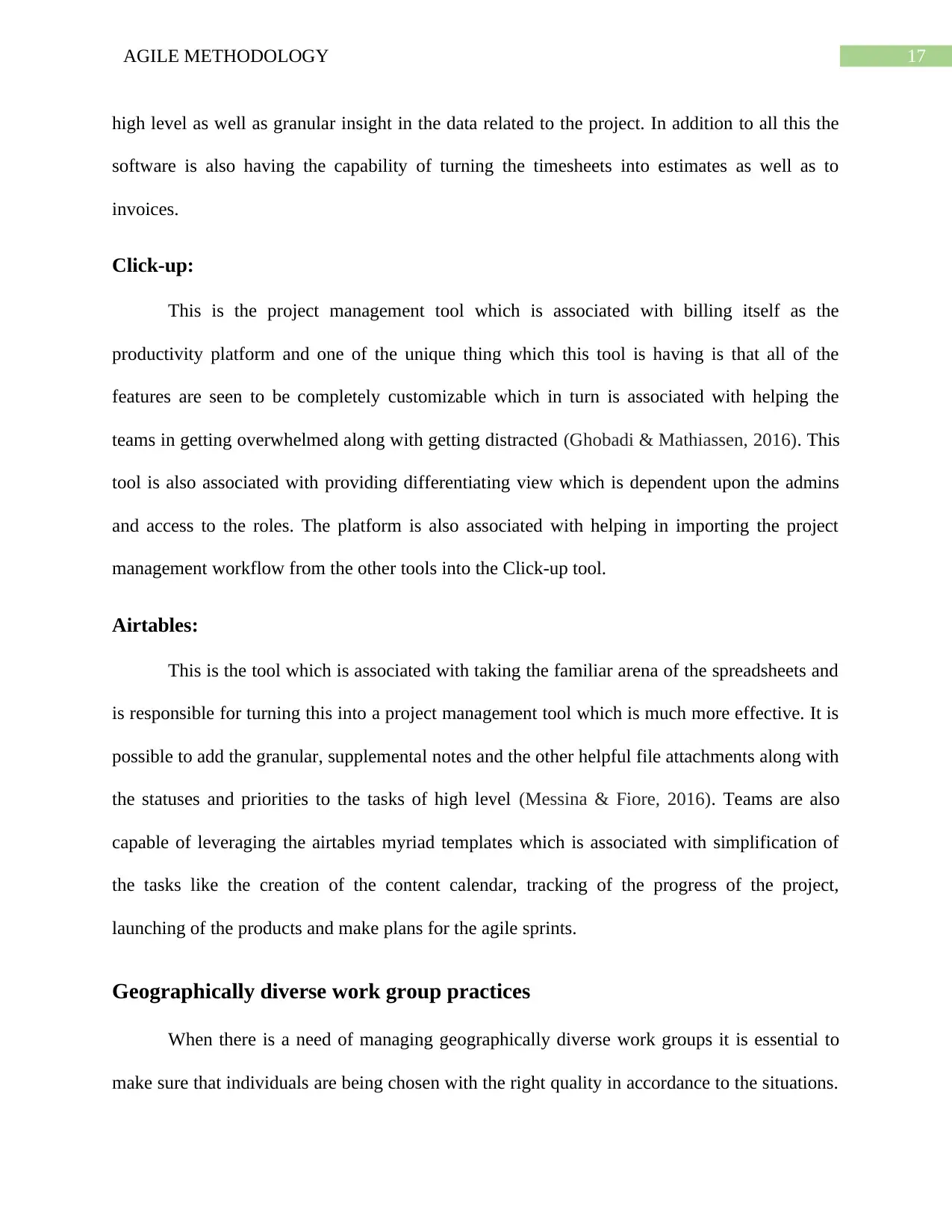
17AGILE METHODOLOGY
high level as well as granular insight in the data related to the project. In addition to all this the
software is also having the capability of turning the timesheets into estimates as well as to
invoices.
Click-up:
This is the project management tool which is associated with billing itself as the
productivity platform and one of the unique thing which this tool is having is that all of the
features are seen to be completely customizable which in turn is associated with helping the
teams in getting overwhelmed along with getting distracted (Ghobadi & Mathiassen, 2016). This
tool is also associated with providing differentiating view which is dependent upon the admins
and access to the roles. The platform is also associated with helping in importing the project
management workflow from the other tools into the Click-up tool.
Airtables:
This is the tool which is associated with taking the familiar arena of the spreadsheets and
is responsible for turning this into a project management tool which is much more effective. It is
possible to add the granular, supplemental notes and the other helpful file attachments along with
the statuses and priorities to the tasks of high level (Messina & Fiore, 2016). Teams are also
capable of leveraging the airtables myriad templates which is associated with simplification of
the tasks like the creation of the content calendar, tracking of the progress of the project,
launching of the products and make plans for the agile sprints.
Geographically diverse work group practices
When there is a need of managing geographically diverse work groups it is essential to
make sure that individuals are being chosen with the right quality in accordance to the situations.
high level as well as granular insight in the data related to the project. In addition to all this the
software is also having the capability of turning the timesheets into estimates as well as to
invoices.
Click-up:
This is the project management tool which is associated with billing itself as the
productivity platform and one of the unique thing which this tool is having is that all of the
features are seen to be completely customizable which in turn is associated with helping the
teams in getting overwhelmed along with getting distracted (Ghobadi & Mathiassen, 2016). This
tool is also associated with providing differentiating view which is dependent upon the admins
and access to the roles. The platform is also associated with helping in importing the project
management workflow from the other tools into the Click-up tool.
Airtables:
This is the tool which is associated with taking the familiar arena of the spreadsheets and
is responsible for turning this into a project management tool which is much more effective. It is
possible to add the granular, supplemental notes and the other helpful file attachments along with
the statuses and priorities to the tasks of high level (Messina & Fiore, 2016). Teams are also
capable of leveraging the airtables myriad templates which is associated with simplification of
the tasks like the creation of the content calendar, tracking of the progress of the project,
launching of the products and make plans for the agile sprints.
Geographically diverse work group practices
When there is a need of managing geographically diverse work groups it is essential to
make sure that individuals are being chosen with the right quality in accordance to the situations.
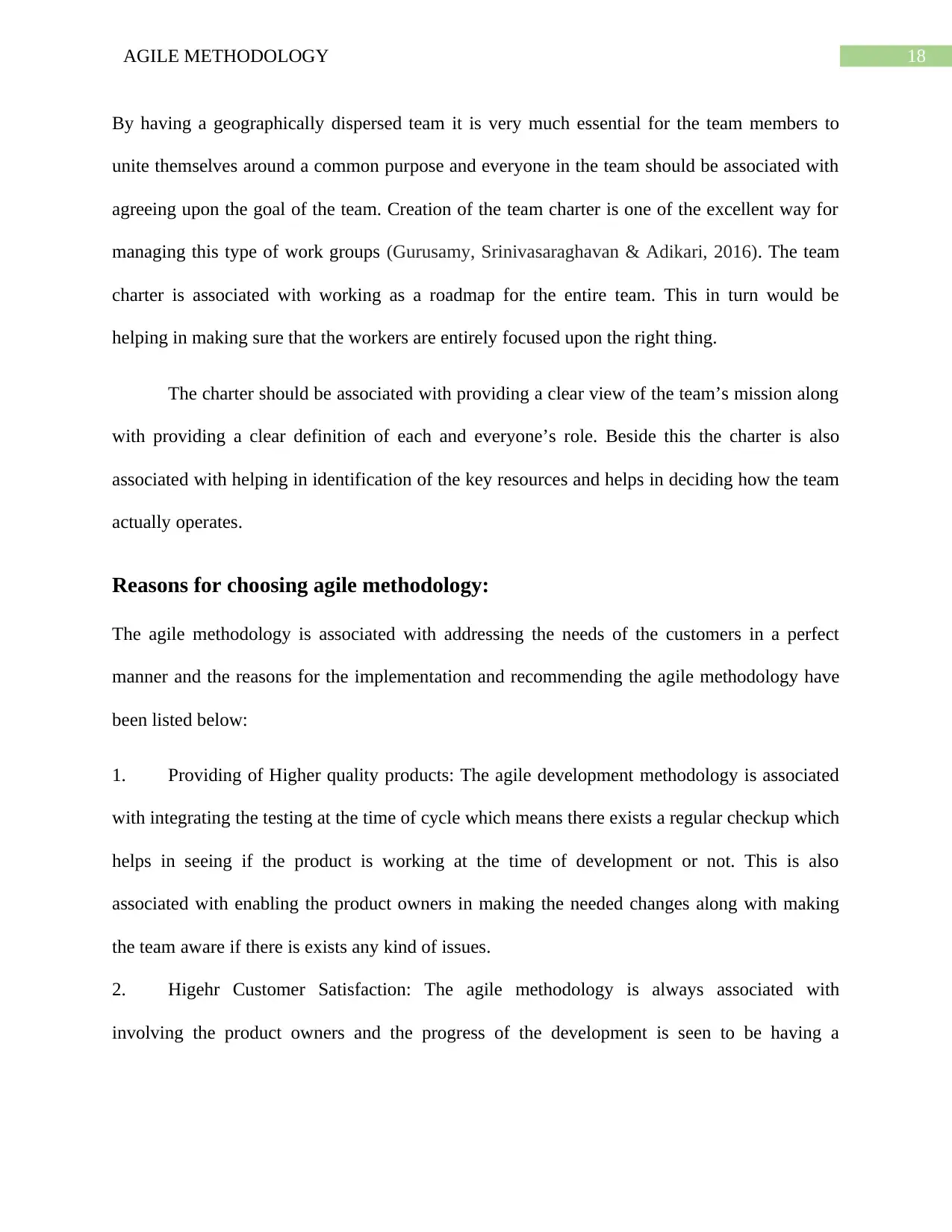
18AGILE METHODOLOGY
By having a geographically dispersed team it is very much essential for the team members to
unite themselves around a common purpose and everyone in the team should be associated with
agreeing upon the goal of the team. Creation of the team charter is one of the excellent way for
managing this type of work groups (Gurusamy, Srinivasaraghavan & Adikari, 2016). The team
charter is associated with working as a roadmap for the entire team. This in turn would be
helping in making sure that the workers are entirely focused upon the right thing.
The charter should be associated with providing a clear view of the team’s mission along
with providing a clear definition of each and everyone’s role. Beside this the charter is also
associated with helping in identification of the key resources and helps in deciding how the team
actually operates.
Reasons for choosing agile methodology:
The agile methodology is associated with addressing the needs of the customers in a perfect
manner and the reasons for the implementation and recommending the agile methodology have
been listed below:
1. Providing of Higher quality products: The agile development methodology is associated
with integrating the testing at the time of cycle which means there exists a regular checkup which
helps in seeing if the product is working at the time of development or not. This is also
associated with enabling the product owners in making the needed changes along with making
the team aware if there is exists any kind of issues.
2. Higehr Customer Satisfaction: The agile methodology is always associated with
involving the product owners and the progress of the development is seen to be having a
By having a geographically dispersed team it is very much essential for the team members to
unite themselves around a common purpose and everyone in the team should be associated with
agreeing upon the goal of the team. Creation of the team charter is one of the excellent way for
managing this type of work groups (Gurusamy, Srinivasaraghavan & Adikari, 2016). The team
charter is associated with working as a roadmap for the entire team. This in turn would be
helping in making sure that the workers are entirely focused upon the right thing.
The charter should be associated with providing a clear view of the team’s mission along
with providing a clear definition of each and everyone’s role. Beside this the charter is also
associated with helping in identification of the key resources and helps in deciding how the team
actually operates.
Reasons for choosing agile methodology:
The agile methodology is associated with addressing the needs of the customers in a perfect
manner and the reasons for the implementation and recommending the agile methodology have
been listed below:
1. Providing of Higher quality products: The agile development methodology is associated
with integrating the testing at the time of cycle which means there exists a regular checkup which
helps in seeing if the product is working at the time of development or not. This is also
associated with enabling the product owners in making the needed changes along with making
the team aware if there is exists any kind of issues.
2. Higehr Customer Satisfaction: The agile methodology is always associated with
involving the product owners and the progress of the development is seen to be having a
Paraphrase This Document
Need a fresh take? Get an instant paraphrase of this document with our AI Paraphraser

19AGILE METHODOLOGY
flexibility as well as feasibility of getting changed whenever needed and this is highly important
as this implies the engagement and the satisfaction of the customers.
3. The project control is highly increased by means of sprint meetings. Beside this the agile
methodology is having high transparence along with providing the visibility of each and every
step of the project for both parties that is the project team and the customer.
4. Reduction of the risks: The agile methodology is associated with virtual elimination of the
chances related to absolute project failures. Besides the agile methodology is always having
working products which starts from the first sprint so as to make sure that the agile project is not
failing.
5. Agile methodology is associated with providing the freedom of implementing the changes
whenever needed. The changes can be implemented by usage of very little cost and this happens
because of the new increments frequency which are produced.
flexibility as well as feasibility of getting changed whenever needed and this is highly important
as this implies the engagement and the satisfaction of the customers.
3. The project control is highly increased by means of sprint meetings. Beside this the agile
methodology is having high transparence along with providing the visibility of each and every
step of the project for both parties that is the project team and the customer.
4. Reduction of the risks: The agile methodology is associated with virtual elimination of the
chances related to absolute project failures. Besides the agile methodology is always having
working products which starts from the first sprint so as to make sure that the agile project is not
failing.
5. Agile methodology is associated with providing the freedom of implementing the changes
whenever needed. The changes can be implemented by usage of very little cost and this happens
because of the new increments frequency which are produced.
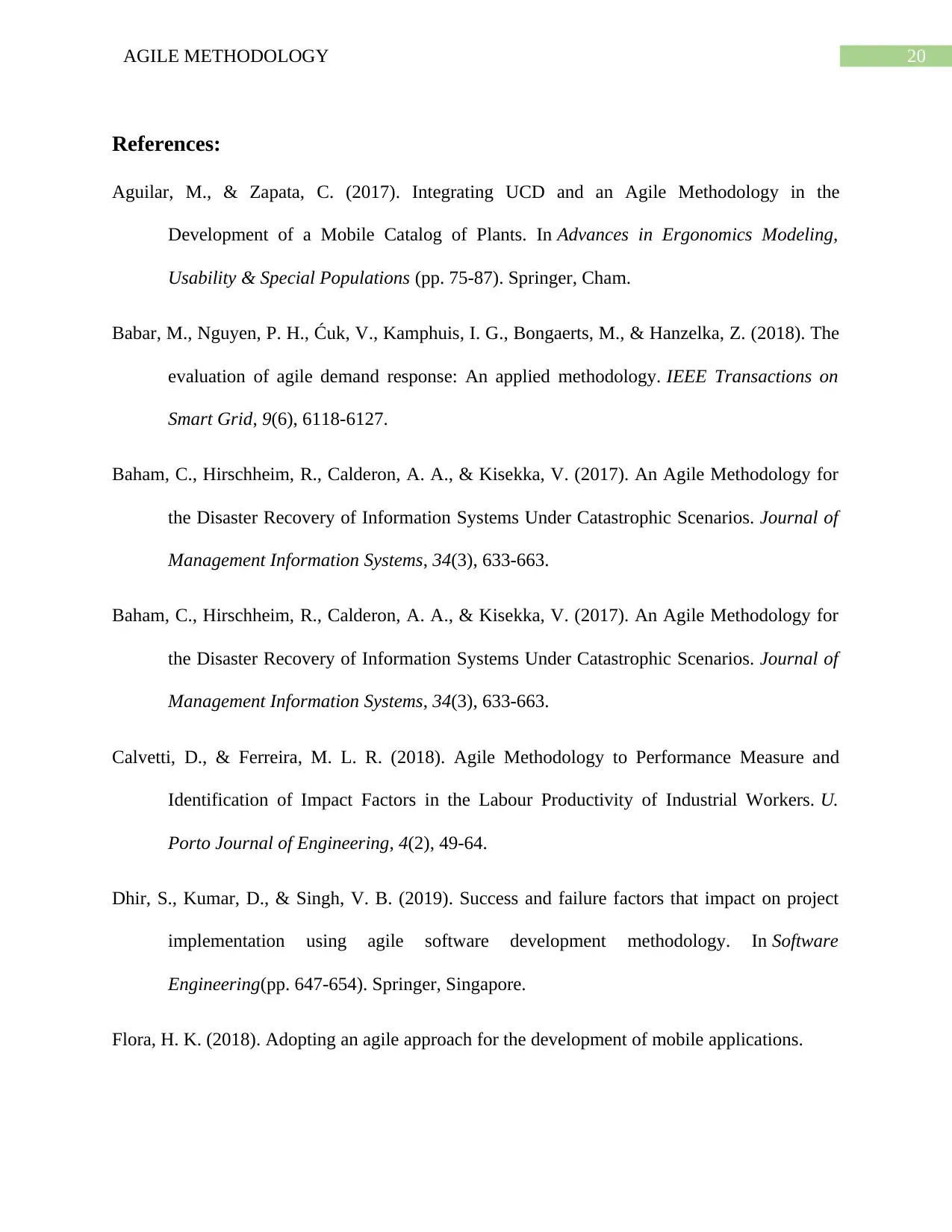
20AGILE METHODOLOGY
References:
Aguilar, M., & Zapata, C. (2017). Integrating UCD and an Agile Methodology in the
Development of a Mobile Catalog of Plants. In Advances in Ergonomics Modeling,
Usability & Special Populations (pp. 75-87). Springer, Cham.
Babar, M., Nguyen, P. H., Ćuk, V., Kamphuis, I. G., Bongaerts, M., & Hanzelka, Z. (2018). The
evaluation of agile demand response: An applied methodology. IEEE Transactions on
Smart Grid, 9(6), 6118-6127.
Baham, C., Hirschheim, R., Calderon, A. A., & Kisekka, V. (2017). An Agile Methodology for
the Disaster Recovery of Information Systems Under Catastrophic Scenarios. Journal of
Management Information Systems, 34(3), 633-663.
Baham, C., Hirschheim, R., Calderon, A. A., & Kisekka, V. (2017). An Agile Methodology for
the Disaster Recovery of Information Systems Under Catastrophic Scenarios. Journal of
Management Information Systems, 34(3), 633-663.
Calvetti, D., & Ferreira, M. L. R. (2018). Agile Methodology to Performance Measure and
Identification of Impact Factors in the Labour Productivity of Industrial Workers. U.
Porto Journal of Engineering, 4(2), 49-64.
Dhir, S., Kumar, D., & Singh, V. B. (2019). Success and failure factors that impact on project
implementation using agile software development methodology. In Software
Engineering(pp. 647-654). Springer, Singapore.
Flora, H. K. (2018). Adopting an agile approach for the development of mobile applications.
References:
Aguilar, M., & Zapata, C. (2017). Integrating UCD and an Agile Methodology in the
Development of a Mobile Catalog of Plants. In Advances in Ergonomics Modeling,
Usability & Special Populations (pp. 75-87). Springer, Cham.
Babar, M., Nguyen, P. H., Ćuk, V., Kamphuis, I. G., Bongaerts, M., & Hanzelka, Z. (2018). The
evaluation of agile demand response: An applied methodology. IEEE Transactions on
Smart Grid, 9(6), 6118-6127.
Baham, C., Hirschheim, R., Calderon, A. A., & Kisekka, V. (2017). An Agile Methodology for
the Disaster Recovery of Information Systems Under Catastrophic Scenarios. Journal of
Management Information Systems, 34(3), 633-663.
Baham, C., Hirschheim, R., Calderon, A. A., & Kisekka, V. (2017). An Agile Methodology for
the Disaster Recovery of Information Systems Under Catastrophic Scenarios. Journal of
Management Information Systems, 34(3), 633-663.
Calvetti, D., & Ferreira, M. L. R. (2018). Agile Methodology to Performance Measure and
Identification of Impact Factors in the Labour Productivity of Industrial Workers. U.
Porto Journal of Engineering, 4(2), 49-64.
Dhir, S., Kumar, D., & Singh, V. B. (2019). Success and failure factors that impact on project
implementation using agile software development methodology. In Software
Engineering(pp. 647-654). Springer, Singapore.
Flora, H. K. (2018). Adopting an agile approach for the development of mobile applications.
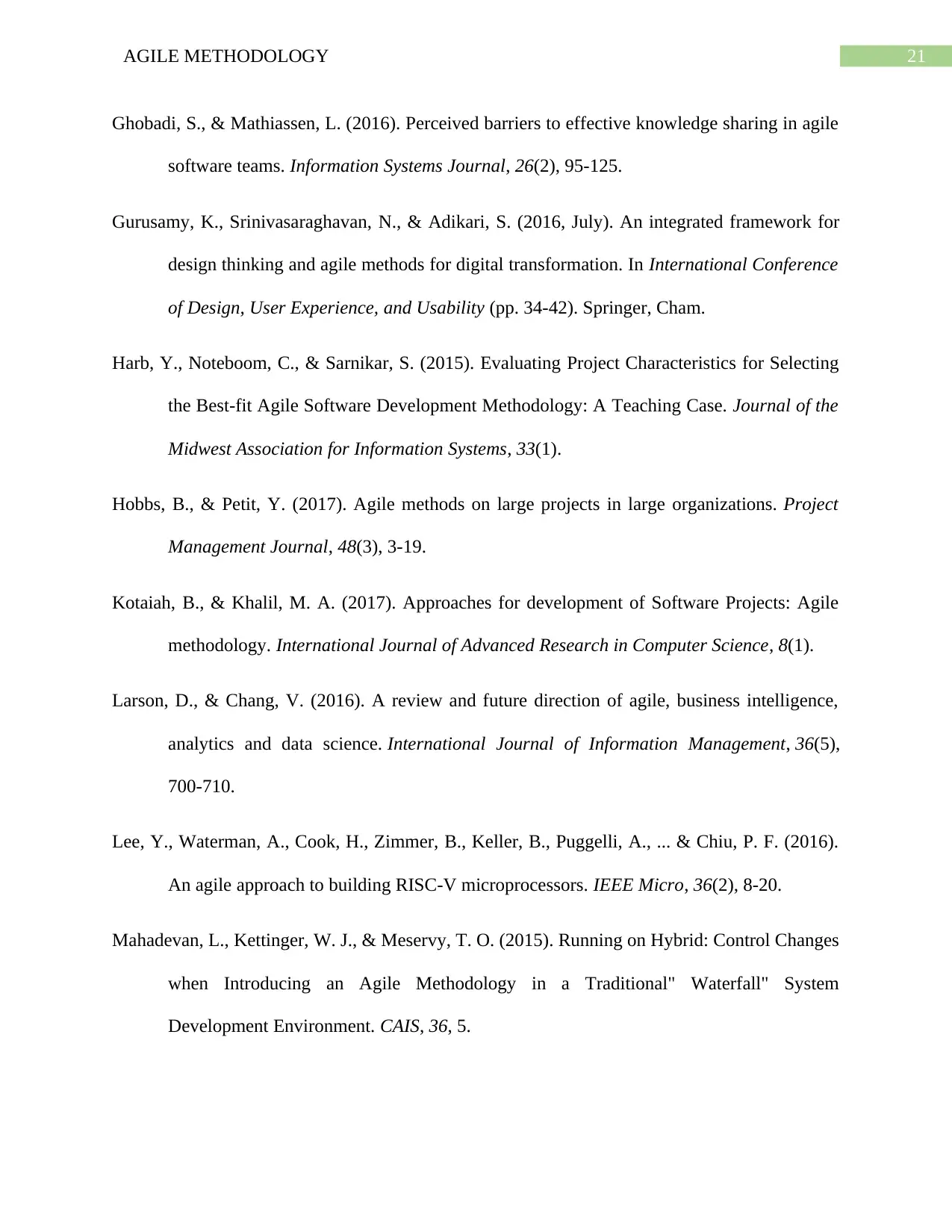
21AGILE METHODOLOGY
Ghobadi, S., & Mathiassen, L. (2016). Perceived barriers to effective knowledge sharing in agile
software teams. Information Systems Journal, 26(2), 95-125.
Gurusamy, K., Srinivasaraghavan, N., & Adikari, S. (2016, July). An integrated framework for
design thinking and agile methods for digital transformation. In International Conference
of Design, User Experience, and Usability (pp. 34-42). Springer, Cham.
Harb, Y., Noteboom, C., & Sarnikar, S. (2015). Evaluating Project Characteristics for Selecting
the Best-fit Agile Software Development Methodology: A Teaching Case. Journal of the
Midwest Association for Information Systems, 33(1).
Hobbs, B., & Petit, Y. (2017). Agile methods on large projects in large organizations. Project
Management Journal, 48(3), 3-19.
Kotaiah, B., & Khalil, M. A. (2017). Approaches for development of Software Projects: Agile
methodology. International Journal of Advanced Research in Computer Science, 8(1).
Larson, D., & Chang, V. (2016). A review and future direction of agile, business intelligence,
analytics and data science. International Journal of Information Management, 36(5),
700-710.
Lee, Y., Waterman, A., Cook, H., Zimmer, B., Keller, B., Puggelli, A., ... & Chiu, P. F. (2016).
An agile approach to building RISC-V microprocessors. IEEE Micro, 36(2), 8-20.
Mahadevan, L., Kettinger, W. J., & Meservy, T. O. (2015). Running on Hybrid: Control Changes
when Introducing an Agile Methodology in a Traditional" Waterfall" System
Development Environment. CAIS, 36, 5.
Ghobadi, S., & Mathiassen, L. (2016). Perceived barriers to effective knowledge sharing in agile
software teams. Information Systems Journal, 26(2), 95-125.
Gurusamy, K., Srinivasaraghavan, N., & Adikari, S. (2016, July). An integrated framework for
design thinking and agile methods for digital transformation. In International Conference
of Design, User Experience, and Usability (pp. 34-42). Springer, Cham.
Harb, Y., Noteboom, C., & Sarnikar, S. (2015). Evaluating Project Characteristics for Selecting
the Best-fit Agile Software Development Methodology: A Teaching Case. Journal of the
Midwest Association for Information Systems, 33(1).
Hobbs, B., & Petit, Y. (2017). Agile methods on large projects in large organizations. Project
Management Journal, 48(3), 3-19.
Kotaiah, B., & Khalil, M. A. (2017). Approaches for development of Software Projects: Agile
methodology. International Journal of Advanced Research in Computer Science, 8(1).
Larson, D., & Chang, V. (2016). A review and future direction of agile, business intelligence,
analytics and data science. International Journal of Information Management, 36(5),
700-710.
Lee, Y., Waterman, A., Cook, H., Zimmer, B., Keller, B., Puggelli, A., ... & Chiu, P. F. (2016).
An agile approach to building RISC-V microprocessors. IEEE Micro, 36(2), 8-20.
Mahadevan, L., Kettinger, W. J., & Meservy, T. O. (2015). Running on Hybrid: Control Changes
when Introducing an Agile Methodology in a Traditional" Waterfall" System
Development Environment. CAIS, 36, 5.
Secure Best Marks with AI Grader
Need help grading? Try our AI Grader for instant feedback on your assignments.
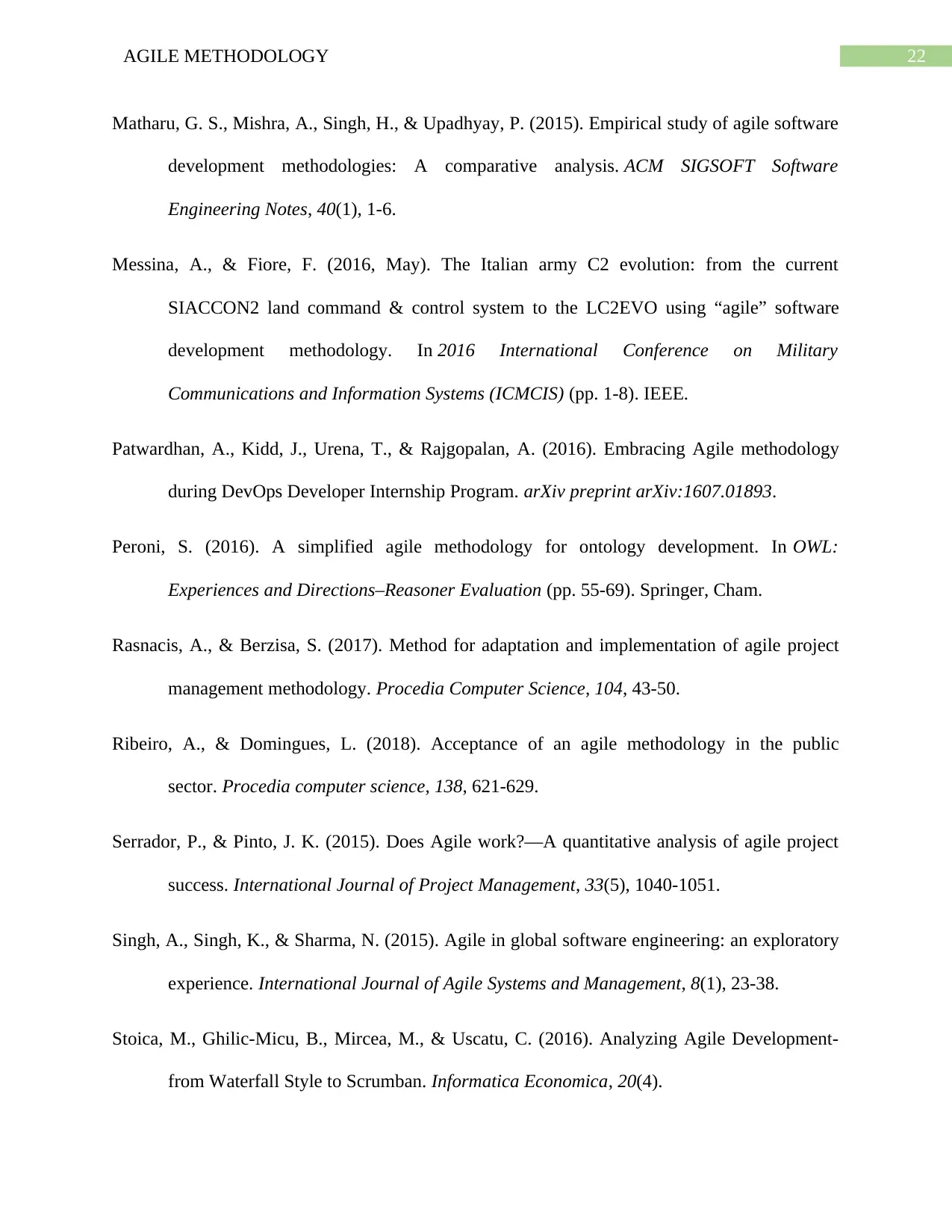
22AGILE METHODOLOGY
Matharu, G. S., Mishra, A., Singh, H., & Upadhyay, P. (2015). Empirical study of agile software
development methodologies: A comparative analysis. ACM SIGSOFT Software
Engineering Notes, 40(1), 1-6.
Messina, A., & Fiore, F. (2016, May). The Italian army C2 evolution: from the current
SIACCON2 land command & control system to the LC2EVO using “agile” software
development methodology. In 2016 International Conference on Military
Communications and Information Systems (ICMCIS) (pp. 1-8). IEEE.
Patwardhan, A., Kidd, J., Urena, T., & Rajgopalan, A. (2016). Embracing Agile methodology
during DevOps Developer Internship Program. arXiv preprint arXiv:1607.01893.
Peroni, S. (2016). A simplified agile methodology for ontology development. In OWL:
Experiences and Directions–Reasoner Evaluation (pp. 55-69). Springer, Cham.
Rasnacis, A., & Berzisa, S. (2017). Method for adaptation and implementation of agile project
management methodology. Procedia Computer Science, 104, 43-50.
Ribeiro, A., & Domingues, L. (2018). Acceptance of an agile methodology in the public
sector. Procedia computer science, 138, 621-629.
Serrador, P., & Pinto, J. K. (2015). Does Agile work?—A quantitative analysis of agile project
success. International Journal of Project Management, 33(5), 1040-1051.
Singh, A., Singh, K., & Sharma, N. (2015). Agile in global software engineering: an exploratory
experience. International Journal of Agile Systems and Management, 8(1), 23-38.
Stoica, M., Ghilic-Micu, B., Mircea, M., & Uscatu, C. (2016). Analyzing Agile Development-
from Waterfall Style to Scrumban. Informatica Economica, 20(4).
Matharu, G. S., Mishra, A., Singh, H., & Upadhyay, P. (2015). Empirical study of agile software
development methodologies: A comparative analysis. ACM SIGSOFT Software
Engineering Notes, 40(1), 1-6.
Messina, A., & Fiore, F. (2016, May). The Italian army C2 evolution: from the current
SIACCON2 land command & control system to the LC2EVO using “agile” software
development methodology. In 2016 International Conference on Military
Communications and Information Systems (ICMCIS) (pp. 1-8). IEEE.
Patwardhan, A., Kidd, J., Urena, T., & Rajgopalan, A. (2016). Embracing Agile methodology
during DevOps Developer Internship Program. arXiv preprint arXiv:1607.01893.
Peroni, S. (2016). A simplified agile methodology for ontology development. In OWL:
Experiences and Directions–Reasoner Evaluation (pp. 55-69). Springer, Cham.
Rasnacis, A., & Berzisa, S. (2017). Method for adaptation and implementation of agile project
management methodology. Procedia Computer Science, 104, 43-50.
Ribeiro, A., & Domingues, L. (2018). Acceptance of an agile methodology in the public
sector. Procedia computer science, 138, 621-629.
Serrador, P., & Pinto, J. K. (2015). Does Agile work?—A quantitative analysis of agile project
success. International Journal of Project Management, 33(5), 1040-1051.
Singh, A., Singh, K., & Sharma, N. (2015). Agile in global software engineering: an exploratory
experience. International Journal of Agile Systems and Management, 8(1), 23-38.
Stoica, M., Ghilic-Micu, B., Mircea, M., & Uscatu, C. (2016). Analyzing Agile Development-
from Waterfall Style to Scrumban. Informatica Economica, 20(4).

23AGILE METHODOLOGY
ur Rehman, F., Maqbool, B., Riaz, M. Q., Qamar, U., & Abbas, M. (2018, April). Scrum
Software Maintenance Model: Efficient Software Maintenance in Agile Methodology.
In 2018 21st Saudi Computer Society National Computer Conference (NCC) (pp. 1-5).
IEEE.
Weber, E. V. (2016). Performance Learning of Agile Methodology Using Paired Courses of
Systems Analysis and Design and Web/Mobile Programming. In Proceedings of the
EDSIG Conference ISSN (Vol. 2473, p. 3857).
Wilson, N. B., & Edgar, C. S. (2016). Agile Methodology for Modeling and Design of Data
Warehouses-AM4DW. World Academy of Science, Engineering and Technology,
International Journal of Computer, Electrical, Automation, Control and Information
Engineering, 9(9), 2132-2137.
ur Rehman, F., Maqbool, B., Riaz, M. Q., Qamar, U., & Abbas, M. (2018, April). Scrum
Software Maintenance Model: Efficient Software Maintenance in Agile Methodology.
In 2018 21st Saudi Computer Society National Computer Conference (NCC) (pp. 1-5).
IEEE.
Weber, E. V. (2016). Performance Learning of Agile Methodology Using Paired Courses of
Systems Analysis and Design and Web/Mobile Programming. In Proceedings of the
EDSIG Conference ISSN (Vol. 2473, p. 3857).
Wilson, N. B., & Edgar, C. S. (2016). Agile Methodology for Modeling and Design of Data
Warehouses-AM4DW. World Academy of Science, Engineering and Technology,
International Journal of Computer, Electrical, Automation, Control and Information
Engineering, 9(9), 2132-2137.
1 out of 24
Related Documents
Your All-in-One AI-Powered Toolkit for Academic Success.
+13062052269
info@desklib.com
Available 24*7 on WhatsApp / Email
![[object Object]](/_next/static/media/star-bottom.7253800d.svg)
Unlock your academic potential
© 2024 | Zucol Services PVT LTD | All rights reserved.





